Bigotry: The Dark Danger
The Evolution Impasse 2
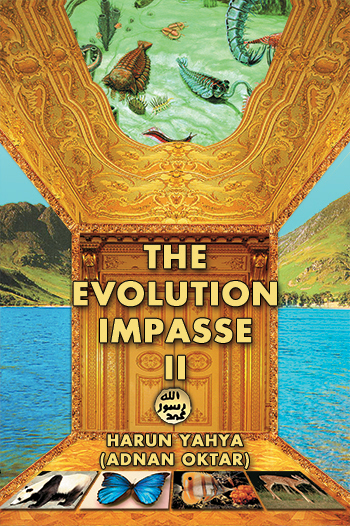
< <
5 / total: 13
O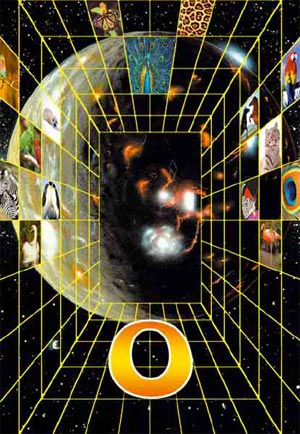 Octopus’s Eye, TheEvolutionists maintain that all living things with similar structures and organs share an evolutionary relationship. One of the perfectly clear examples that invalidate this claim, known as homology, is the octopus eye. (See Homology.) According to evolutionists’ imaginary tree of life, octopi —being mollusks—are one of the life forms furthest removed from human beings. Although the octopus and man are very different life forms, between which no so called evolutionary relationship can exist, their eyes have exactly the same structure! This is a clear sign that similar structures do not constitute proof of evolution. Confronted by this situation, evolutionists say that these organs are not homologous (that is, descended from a common ancestor) but rather analogous—similar, despite the absence of any evolutionary relationship. See Homologous Organs and Analogous Organs.) In their view, for instance, the human eye and the octopus eye are analogous organs. However, the question of whether a particular organ should be included in the homologous or the analogous category is answered solely according to the preconceptions of the theory of evolution. This in turn shows that there is nothing scientific about the evolutionist claim based on similarities. All evolutionists seek to do is to interpret the findings they discover against the terms of evolution dogma, which they assume to be true right from the outset. Yet the interpretations they come up with are highly inconsistent. Because sometimes organs they are forced to regard as analogous resemble one another so closely, despite their extraordinarily complex structures, that it is utterly illogical to suggest that such resemblances came about as the result of random mutations. If, as evolutionists claim, the octopus’s eye emerged as the result of chance, then the vertebrate eye should have emerged by repeating those exact same coincidences. The well-known evolutionist Frank Salisbury writes: Even something as complex as the eye has appeared several times; for example, in the squid, the vertebrates, and the arthropods. It’s bad enough accounting for the origin of such things once, but the thought of producing them several times according to the modern synthetic theory makes my head swim.74 According to the theory of evolution, completely independent mutations must have produced these life forms twice, by chance! This fact places evolutionists in an even worse dilemma. Extraordinary similarities like these, which conflict with the evolutionist thesis of homology, show that similar organs represent no evidence for having evolved from a common ancestor. Indeed, the exact opposite can be observed in some life forms: Some living things, despite being regarded by evolutionists as very closely related, have some organs that are completely different from one another. OH 62: A Species of ApeEvolutionists long suggested that the fossil creature to which they gave the name Homo habilis was capable of walking upright. They thus thought that they had found a link between ape and man. However, the new H. habilis fossils discovered by Tim White in 1986 and given the name OH 62 demolished that claim. These fossil parts showed that, just like present-day apes, H. habilis had long arms and short legs. This fossil put an end to the claim that H. habilis was capable of walking upright. It was nothing more than a species of ape. Ontogeny Recapitulates Phylogeny Theory, The(See also The, Biogenetic Law and Theory of Recapitulation,) The evolutionist biologist Ernst Haeckel proposed this theory toward the end of the 19th century. The term recapitulation is used to summarize the theory. Haeckel claimed that during their developmental phases, embryos repeated the evolutionary process that their alleged ancestors had undergone. For example, he maintained that during its development in the mother’s womb the human embryo exhibited first fish-like gills and then reptile characteristics before finally “evolving” into a human baby. However, as time passed, it emerged that this scenario was totally imaginary. Evolutionists also admit this. One article in American Scientist read: Surely the biogenetic law [the recapitulation theory] is as dead as a doornail. It was finally exorcised from biology textbooks in the fifties. As a topic of serious theoretical inquiry it was extinct in the twenties. 75 To support his theory of recapitulation, Ernst Haeckel produced faked drawings, attempting to portray fish and human embryos as resembling one another. When these frauds were exposed, he had no other defense other than to say that other evolutionists did exactly the same thing: After this compromising confession of ‘forgery’ I should be obliged to consider myself condemned and annihilated if I had not the consolation of seeing side by side with me in the prisoner’s dock hundreds of fellow-culprits, among them many of the most trusted observers and most esteemed biologists. The great majority of all the diagrams in the best biological textbooks, treatises and journals would incur in the same degree the charge of ‘'forgery,’ for all of them are inexact, and are more or less doctored, schematised and constructed. 76 Oparin, Alexander I.
Alexander I. Oparin The Russian biologist Alexander I. Oparin, founder of the concept of “chemical evolution,” could not obtain any findings to shed light on the origins of life, despite all his theoretical research. In his 1936 book The Origin of Life, he wrote, “Unfortunately . . . the problem of the origin of the cell is perhaps the most obscure point in the whole study of the evolution of organisms.” 77 Ever since Oparin, evolutionists have carried out countless experiments, studies and observations to prove that the cell could have come into existence by chance. However, every study has undermined evolutionists’ assumptions by revealing in ever-greater detail the complex creation in the cell. Open SystemThe term “open system” refers to a thermodynamic system with an external energy source, into which matter enters and departs. Since the theory of evolution conflicts with the Second Law of Thermodynamics (the Law of Entropy), evolutionists maintain that this entropy applies only to closed systems. They resort to a deception, maintaining that open systems lie outside this law. They suggest, further, that the Earth’s biosphere is an open system, being exposed to a constant flow of energy from the Sun; and that therefore, the Law of Entropy does not apply to the Earth, and that ordered, complex living things can indeed emerge from disordered, simple and inanimate structures. Yet there is a very clear distortion of the facts here, because energy entering a system from outside is not sufficient to make that system into an ordered one. To make that energy capable of being used, special mechanisms are needed. For example, control mechanisms, an engine and transmission systems are needed to harness the energy generated from the fuel in an internal combustion engine. In the absence of such transformation systems, it will be impossible to use that fuel’s energy. The same applies to living things, which receive their energy from the Sun. This solar energy is turned into chemical energy thanks to extraordinarily complex energy-conversion systems such as photosynthesis in plants and the digestive systems in animals and human beings. In the absence of any of these conversion systems, no organism can survive. For a living thing with no energy-conversion system, the Sun will be simply a source of destructive heat and UV radiation. Therefore, any system without an energy-conversion system be it open or closed, will offer no advantage for evolution. No one claims that any such complex and conscious mechanism existed in the conditions of the primeval Earth. At this point, evolutionists cannot account for how complex energy conversion systems, such as photosynthesis, which even modern technology cannot reproduce — emerged in the first place. Whatever solar energy reached the primeval Earth had no way of giving rise to order. For one thing, the higher the temperature rises, the more amino acids—the building blocks of life—resist forming bonds in regular sequences. Energy alone is not sufficient for amino acids to form the far more complex molecules of proteins, and for proteins to give rise to cell organelles, which are more complex still. This manifest order is only possible through our omniscient Lord’s creation. In fact, many evolutionists openly admit that the claim about open systems is invalid and that it conflicts with thermodynamics. Although Professor John Ross of Harvard University holds evolutionist views, he writes in a paper in Chemical and Engineering News that this claim is unrealistic and unscientific: . . . there are no known violations of the second law of thermodynamics. Ordinarily, the second law is stated for isolated systems, but the second law applies equally well to open systems. . . . there is somehow associated with the field of far-from-equilibrium phenomena the notion that the second law of thermodynamics fails for such systems. It is important to make sure that this error does not perpetuate itself. 78 Ordered SystemThe theory of evolution clearly conflicts with the second law of thermodynamics (the law of entropy), one of the most basic laws of physics. (See The Second Law of Thermodynamics) According to this experimentally proven theory, all systems in the universe, left to their own devices, will suffer disorder, disruption and impairment in direct relation to the passage of time. In order not to violate this scientific law, evolutionists use various concepts in a misleading manner. They maintain that specific order can arise in systems undergoing constant exchanges of matter and energy. For example, when wind enters a dusty room, it may move all the dust that has settled and deposit it in one corner of the room. However, these dust particles can never order themselves by using the energy of the wind to produce a recognizable image of, say, a human being. Similarly, when the A key on a keyboard is pressed repeatedly (with a corresponding flow of energy entering the system), the result is dozens of repetitions of the letter, as in aaaaaaaaaaaaaaaaa . . . However, this constant repetition contains no information, no complexity. For a sequence of letters to contain information in the form of a meaningful sentence, paragraph or book, an intelligent, ordering mind is absolutely essential. As a result, no complex, organized system can ever arise through natural processes, although simple combinations of the kind described above may occur from time to time. These arrangements never go beyond specific limits, however. Yet evolutionists depict examples of self-ordering that arise spontaneously in this way as significant evidence for evolution, portraying them as supposed examples of self-organization. As a result of this misconception, they suggest that living systems can emerge spontaneously as a result of natural chemical reactions. However, ordered systems and organized systems have totally distinct structures. Ordered systems include simple arrangements and repetitions, while organized systems contain very complex and interconnected structures and functions. Knowledge and conscious design are essential if they are to emerge. Ilya Prigogine resorted to this deliberate conceptual confusion and referred to molecules that arranged themselves as energy passed through them as “spontaneously self-organizing.” In their book The Mystery of Life’s Origin, the American scientists Thaxton, Bradley and Olsen describe the position in these terms: In each case random movements of molecules in a fluid are spontaneously replaced by a highly ordered behaviour. Prigogine, Eigen, and others have suggested that a similar sort of self-organization may be intrinsic in organic chemistry and can potentially account for the highly complex macromolecules essential for living systems. But such analogies have scant relevance to the origin-of-life question. A major reason is that they fail to distinguish between order and complexity. . . .79 Those same scientists also describe the logical superficiality and distortion of some evolutionists’ claim that water turning into ice is an analogy of biological ordering taking place spontaneously. It has often been argued by analogy to water crystallizing to ice that simple monomers may polymerize into complex molecules such as protein and DNA. The analogy is clearly inappropriate, however . . . The atomic bonding forces draw water molecules into an orderly crystalline array when the thermal agitation (or entropy driving force) is made sufficiently small by lowering the temperature. Organic monomers such as amino acids resist combining at all at any temperature, however, much less [forming] some orderly arrangement. 80 Prigione devoted his whole career to trying to square thermodynamics with the theory of evolution. But even he admitted that there was no resemblance between the crystallization of water and the emergence of complex biological structures: The point is that in a non-isolated system there exists a possibility for formation of ordered, low-entropy structures at sufficiently low temperatures. This ordering principle is responsible for the appearance of ordered structures such as crystals, as well as for the phenomena of phase transitions. Unfortunately, this principle cannot explain the formation of biological structures. 81 Organized Systems—See Ordered System Orgel, LeslieProbability calculations show that complex molecules such as proteins and nucleic acid (RNA and DNA) cannot possibly come into being separately and by chance. Prominent evolutionists admit this. For example, Stanley Miller and Francis Crick’s colleague from San Diego University, the well-known evolutionist Dr. Leslie Orgel, says: It is extremely improbable that proteins and nucleic acids, both of which are structurally complex, arose spontaneously in the same place at the same time. Yet it also seems impossible to have one without the other. And so, at first glance, one might have to conclude that life could never, in fact, have originated by chemical means. 82 Origin of the Avian LungAnother factor that makes the scenario of evolution from dinosaur to bird impossible is the unique structure of the avian lung, which cannot be explained in evolutionary terms. The lungs of terrestrial animals have a two-way structure: During inhalation, air travels down into the lungs through increasingly narrower channels, halting at tiny air sacs, where the exchange of oxygen and carbon dioxide takes place. Later, this CO2-laden air moves in the opposite direction, leaving the lung by the same path through which it entered, and is expelled through the main bronchial passage. In birds, on the other hand, the air travels in one way only along the so-called pulmonary canal. The lungs’ entry and exit canals are different from one another, and air always travels in the same direction, thanks to the special air sacs extending along the passages. This means a bird can absorb oxygen in the air non-stop, meeting its high energy requirements. 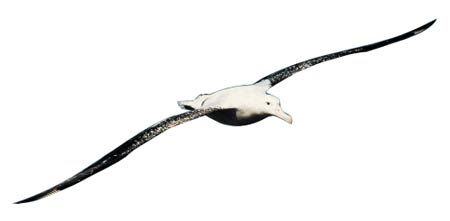 This unique respiratory system, known as the avian lung, is described in these terms by Michael Denton, a molecular biologist from Otega University in Australia: In the case of birds, the major bronchi break down into tiny tubes which permeate the lung tissue. These so-called parabronchi eventually join up together again, forming a true circulatory system so that air flows in one direction through the lungs. . . [T]he structure of the lung in birds and the overall functioning of the respiratory system is quite unique. No lung in any other vertebrate species is known which in any way approaches the avian system. Moreover, it is identical in all essential details in birds as diverse as humming birds, ostriches and hawks. 83 It is impossible for the reptilian lung, with its two-way air flow, to have evolved into the avian lung, with a one-way flow. No transitional stage between these two pulmonary structures is possible. Any vertebrate must breathe in order to survive, and the first step in any change of pulmonary structure would lead to the death of that intermediate stage.  Furthermore, the theory of evolution maintains that all changes took place gradually, over millions of years. Yet no creature whose lungs do not function can survive for more than a few minutes. In his book A Theory in Crisis, Michael Denton sets out the impossibility of explaining the origin of the avian lung from an evolutionary perspective: This one-directional flow of air is maintained in breathing in and breathing out by a complex system of interconnected air sacs in the bird’s body, which expand and contract in such a way as to ensure a continuous delivery of air through the parabronchi . . . The structure of the lung in birds, and the overall functioning of the respiratory system, are quite unique. No lung in any other vertebrate species in any way approaches the avian system. Moreover, in its essential details, it is identical in [all] birds. 84 In short, a transition from one type of lung to the other is not possible, because no “transitional” lung could function properly.
LEFT PICTURE: REPTILE LUNG
1.air in out, 2.alveol, 3.bronchia
RIGHT PICTURE: BIRD LUNG
1.air in, 2.parabronchia, 3.air out The anatomy of birds is very different from that of reptiles, their supposed ancestors. Birds lungs funtionin a totally different way from those of land-dwelling animals. Landdwelling animals breathein and out from the same air vessel. In birds, while the air enters in to the lung from front, it goes out from the back. This distinct system is specially made for birds, which need great amounts of oxygen during flight. It is impossible for such a structure to evolve from the reptile lung. In addition, reptiles have a diaphragmatic respiratory system, while birds have no diaphragm. The differing structures also make evolution between the two types impossible. John Ruben, an authority on respiratory physiology, comments: 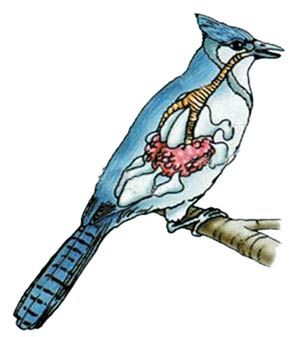 The earliest stages in the derivation of the avian abdominal air sac system from a diaphragm-ventilating ancestor would have necessitated selection for a diaphragmatic hernia in taxa transitional between theropods and birds. Such a debilitating condition would have immediately compromised the entire pulmonary ventilatory apparatus and seems unlikely to have been of any selective advantage. 85 Still another feature refuting the evolution of the avian lung is that its structure leaves it never empty of air, and faces the danger of collapse if it should become empty. Michael Denton has this to say: Just how such a different respiratory system could have evolved gradually from the standard vertebrate design without some sort of direction is, again, very difficult to envisage, especially bearing in mind that the maintenance of respiratory function is absolutely vital to the life of the organism. Moreover, the unique function and form of the avian lung necessitates a number of additional unique adaptations during avian development. As H. R. Dunker, one of the world's authorities in this field, explains, because first, the avian lung is fixed rigidly to the body wall and cannot therefore expand in volume and, second, because of the small diameter of the lung capillaries and the resulting high surface tension of any liquid within them, the avian lung cannot be inflated out of a collapsed state, as happens in all other vertebrates after birth. The air capillaries are never collapsed as are the alveoli of other vertebrate species; rather, as they grow into the lung tissue, the parabronchi are from the beginning open tu bes filled with either air or fluid.86 BIRDS’ SPECIAL RESPIRATORY SYSTEM 
WHEN INHALING
WHEN EXHALING
There are a great many other details in this respiratory system, which this diagram depicts in very simplified form in. For instance, at the points where the air sacs are connected to the lungs, there are special valves and plugs to ensure the air travels in the right direction. These all represent a fatalblow to the idea of evolution, as well as being evident proofs of creation. Allah has created birds to gether with all their flawless characteristics. Allah is the Almighty Creator. This system, totally different from the lungs of reptiles and other terrestrial vertebrates, cannot have formed gradually through unconscious mutations, as evolution maintains. Denton states that the avian lung’s structure invalidates Darwinism: The avian lung brings us very close to answering Darwin's challenge: “If it could be demonstrated that any complex organ existed, which could not possibly have been formed by numerous, successive, slight modifications, my theory would absolutely break down.” 87 
Parabronchial tubes, which enable air to circulate in the right direction in birds’ lungs. Each of these tubes is just 0.5 mm. indiameter. Origin of the BacteriaThe oldest fossils are those of 3.5 billion year-old bacteria. From these remains, evolutionists claim that lifeless matter produced the first single-celled bacterium and claim, further that the first bacteria changed into multi-celled creatures over the course of time and became the ancestors of today’s highly complex plants and animals. But with no scientific proof for these claims, evolutionists cannot explain how lifeless matter could have produced bacteria. Until recently, many scientists regarded bacteria as a simple life form. But detailed research has shown that they are quite complex, even though they are minute, single-celled creatures. 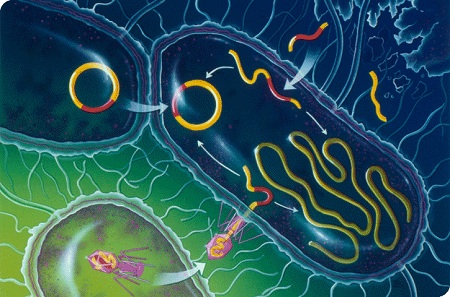
Despite being very small and single-celled, bacteria have a very complex structure. Nearly all species of bacteria are surrounded by a protective wall that shapes their cells and allows them to thrive in quite different environments. Some species of bacteria possess a thin layer which surrounds the cell wall. Within the cell wall of all bacteria, there is an elastic cell membrane. Tiny nutrient molecules enter the cell through pores on the surface of this membrane, through which larger molecules cannot pass. Inside the membrane is a soft, gelatin-like substance called cytoplasm, which contain proteins called enzymes. These provide the cell with the raw materials it needs by breaking down the absorbed nutrients. Like all living cells, bacteria contain DNA that controls the growth, reproduction and other activities. In bacteria, DNA moves freely in the cell’s cytoplasm. Apart from cells without nuclei (called prokaryotes), every cell contains DNA in its nucleus, separated from the cytoplasm by a membrane. Within these cells occur vital bio-chemical activities that ensure the continuation of life on Earth. Bacteria perform essential functions in the planet’s ecological system. For example, some bacteria break down dead plant and animal matter, converting them into basic “raw” chemical compounds that living organisms can reuse. Some bacteria increase the fertility of the soil. Others convert milk into cheese, produce antibiotics for use against other harmful bacteria, and synthesize vitamins. These are only a few of the countless purposes that bacteria serve.A close look at these bacteria’s genetic structure shows that they are not simple life forms at all. Besides all their hundreds of characteristics, bacteria contain the DNA that is evidence of creation. In theta-x-174, the smallest known bacteria, there are 5375 nucleotides—the building blocks of the nucleic acids that control all the hereditary characteristics of living creatures. A normal-sized bacterium contains as many as 3 million nucleotides.88 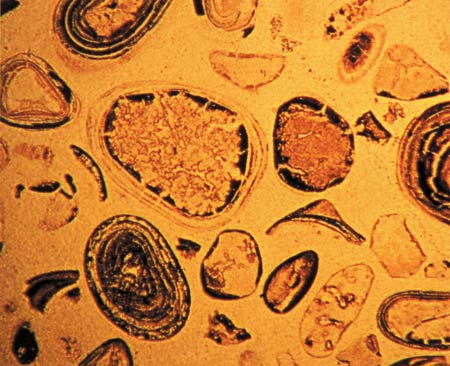
These 1.9-million-year-old fossilized bacteria, discovered in western Ontario, have the same structure as bacteria living today. Since the beginning of the 1900s, various studies of the intestinal bacteria Escherichia coli have shown that one of its chromosomes contains 5,000 genes. (Genes are special areas formed by particles on the DNA determining the function of an organ or a protein.) This information is encoded in the DNA of every bacterium and is vital for its survival; the slightest change in it would destroy the bacterium’s whole functioning system. If stretched out, the length of the information-carrying chromosome inside a typical bacterial cell, which itself is only about 1 to 5 microns in size, is 1,400 microns89 (A micron is 0.001 of a millimeter, or 0.000039 of an inch.) By special design, this wonderful chain of information is folded and packed to fit inside a tiny organism thousands of times smaller than itself. As you can see, the slightest problem in the gene coding would result in the failure of its operational system. Bacteria would not survive, and their lineage would come to an end. As a result, the critical ecological balance would be broken, and the entire world of living things would be upset. Considering these complex characteristics, we understand—contrary to what evolutionists claim — that bacteria are not primitive at all. Moreover, again contrary to the evolutionist claims, the evolution of bacteria into the so-called eukaryotic cells of plants and animals goes against every biological, physical and chemical law. Even though supporters of the evolutionary theory are completely aware of this, they do not abandon their untenable claims. For example, Dr. Ali Demirsoy, an evolutionist professor, admits that these bacteria cells, claimed to be primitive, cannot change into eukaryotic cells: One of the most difficult stages of evolution to explain scientifically is how organelles and complex cells could develop from these primitive life forms. Actually, a transitional form between these two forms has not been found. Single-celled and multi-celled have this complex structure. No single life form or group of life forms has been found that is more primitive or has organelles with a simpler structure. That is, the carried organelles developed with all their characteristics. There is no simple or primitive form.90 Origin of the BatsBats, the only flying mammals, are without doubt one of the most interesting creatures in their class. Heading the list of bats’ fascinating characteristics is the complex sonar system they possess, thanks to which bats are able to fly and perform aerobatic maneuvers in pitch darkness, where they cannot see at all. They are able to detect and catch a tiny caterpillar on the floor of a pitch-black room. The bat works this sonar by emitting a constant stream of high-frequency sounds, analyzing the echoes made by them, and thus obtaining a detailed perception of its surroundings. It does this at an extraordinary speed, non-stop and perfectly during the time it spends in flight. Research into the sonar system in bats has revealed even more astonishing discoveries. The frequency range the bat can detect is very narrow, and since it can perceive sounds only within a specific range, a very important problem arises. According to the physical phenomenon known as the Doppler Effect, the frequency of a sound changes when it reflects off a moving body. Therefore, when a bat emits sound waves in the direction of a moth flying away from it, the returning sound waves will be below the frequency that the bat can detect. For that reason, the bat should have enormous difficulty in detecting its moving prey. 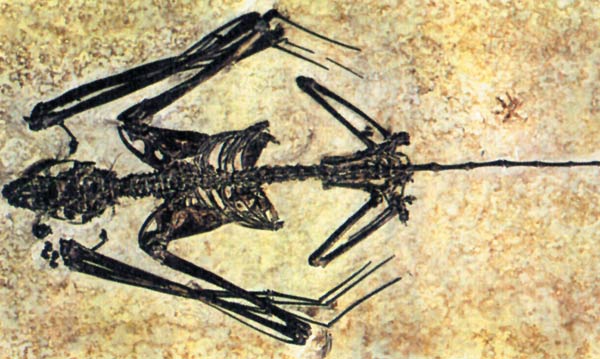
The oldest known fossil bat, found in Wyoming in the USA. This fossil, some 50 million years old, is identical to modern bats. Yet that is not actually the case, and bats continue to detect all kinds of moving object with no problem at all, because they raise the frequency of the sound waves they emit towards moving objects, just as if they were taking the Doppler Effect into account. For example, a bat will emit the highest frequency sounds in the direction of a fly moving away from it, so that when the sound echoes back, it will not fall below a detectable frequency. Two types of neurons or nerve cells in the bat’s brain supervise the sonar system; one of these perceives the ultrasound emitted, and the other adjusts the bat’s squeaks by issuing commands to particular muscles. These two types of neuron work together, so that when the frequency of the echoes changes, the first neuron detects this and causes the other neuron to adapt to the echo’s frequency, either by suppressing or stimulating it. As a result, the bat changes its frequency according to its surroundings, using it in the most efficient manner. It is easy to realize the lethal blow that this system deals to the theory of evolution’s explanation of gradual improvements by way of random mutations. The sonar system in bats has an exceedingly complex structure, and can never be accounted for in terms of random mutations. In order for the system to function, it must exist fully formed and complete, right down to the smallest details. The sonar will work only if the bat has the proper structure for emitting high-frequency sounds, the organs with which to detect and analyze these, and a system capable of varying the frequency, depending of changes in movement. Such sophistication cannot, of course, be explained in terms of random chance, but actually shows that the bat was created in the most perfect manner. In addition, the fossil record also shows that bats appeared suddenly on Earth, and with all their present-day characteristics. The evolutionist paleontologists John Hill and James Smith make the following confession: The fossil record of bats extends back to the early Eocene . . . and has been documented . . . on five continents . . . [A]ll fossil bats, even the oldest, are clearly fully developed bats and so they shed little light on the transition from their terrestrial ancestor.91 On the same subject, the evolutionist paleontologist L. R. Godfrey writes: There are some remarkably well preserved early Tertiary fossil bats, such as Icaronycteris index, but Icaronycteris tells us nothing about the evolution of flight in bats because it was a perfectly good flying bat. 92 It is impossible for the bat’s complex bodily systems to have emerged through evolution, and the fossil records confirm that no such evolution ever took place. On the contrary, the first bats that came into being on Earth were exactly the same as their present-day counterparts. Bats have always existed as bats. Origin of Behavior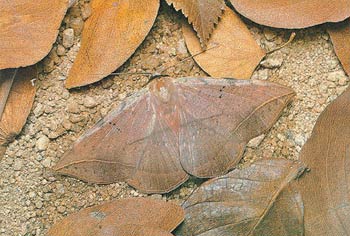
A butterfly that resembles a dry leaf Evolutionists regard all animal and human behavior as having specific evolutionary origins, believing that the present characteristics they possess have been passed down from their supposed ancestors, from the first cell through to their present-day forms. Again according to evolutionists, the oldest form of behavior in animals is food-gathering, which behavior is common to all living things, from the first cells up to human beings. Impulses to survive (self-preservation) and to reproduce and preserve the race or species emerged later.. According to evolutionists, all behavior has one origin and one single cause, and underwent appropriate changes during adaptation to various environmental conditions. However, nothing about behavior squares with an evolutionary scenario. Because living things lack the reasoning abilities to learn by trial and error, and then record these lessons as “instinct” in the genes, and transmit them to subsequent generations. Right from birth, they possess such innate forms of behavior as defending themselves and nest -building.. Allah creates all living things with their own unique attributes and forms of behavior. It is impossible, for instance, for a butterfly to decide to assume the appearance of a dead leaf in order to camouflage itself and increase its chances of survival, and then refine the changes in its wings with that goal in mind. There can be no question of a beaver learning to build a dam, requiring highly advanced engineering calculations, across a river in order to stop the flow of water. It possesses the ability to do this from the moment of its birth. Evolutionists sometimes claim that animals acquire some forms of behavior through experience, and the most effective behaviors become “fixed” by way of natural selection. These effective forms of behavior are subsequently passed on to later generations through genetic inheritance. However, living things cannot survive in the absence of these instinctive forms of behavior. And therefore, they have no time in which to learn them. A living thing has to possess this behavior from the moment it is born. The idea that such behavior can “evolve” is therefore inconsistent right from the start, because evolutionist hypotheses allow for no consciousness to make any such selection. Living things are born possessing of various characteristics and instinctive forms of behavior that allow them to survive. Origin of the BirdsThe theory of evolution maintains that birds descended from small, carnivorous theropod dinosaurs—in other words, from reptiles. In fact, however, comparison of birds and reptiles reveals that these classes are very different from one another, and that no evolution between them is possible. 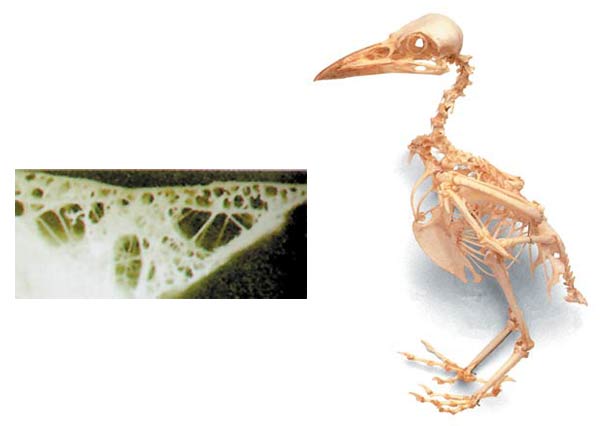
Because of their heavy, bulky bodies, dinosaur bones are very thick and solid. On the other hand, the bones of all birds living today and that have so far been discovered as fossils are hollow and thus very light. There are many structural differences between birds and reptiles, one of the most important of which is bone structure. The bones of dinosaurs are thick and solid. In contrast, the bones of both living and extinct species of birds are hollow, which makes them very light. Reptiles have the slowest metabolism in the living world, while birds hold the record for the fastest. For example, due to its rapid metabolism, a sparrow’s body temperature may sometimes reach 48 degrees Celsius. But reptiles are unable to produce their own body heat, warming themselves by means of the Sun’s rays. Reptiles consume the least energy, and birds the most. Despite being an evolutionist, North Carolina University’s Professor Alan Feduccia opposes the theory that birds are related to dinosaurs. His opposition to the dino-bird claims is based on scientific findings: “All in all, I find the whole dino-bird business a total hoax.” 93 Larry Martin, a Kansas University authority on ancient birds, also opposes the theory that birds are descended from dinosaurs. In reference to the dilemma in which evolution finds itself, Martin says: To tell you the truth, if I had to support the dinosaur origin of birds with those characters, I’d be embarrassed every time I had to get up and talk about it. 94 In the face of all the scientific findings, however, the dinosaur-bird evolution scenario, based on no concrete evidence whatsoever, is still stubbornly defended. Certain concepts that represent no evidence for this scenario are superficially portrayed as “evidence” for the link between birds and dinosaurs. Some evolutionist publications, for instance, suggest that, based on differences in dinosaurs’ hip bones, birds evolved from dinosaurs. The hip bone difference in question is that between the Saurischian (reptile-type hip-boned) and Ornithischian (bird-type hip-boned) groups. This concept of dinosaurs with bird-type hips is sometimes perceived as evidence for dinosaur-to-bird evolution. In fact, however, this provides no support for the claim that dinosaurs are the forerunners of birds. Certain dinosaurs belonging to the Ornithischian group do not resemble birds at all in their other anatomical features. Ankylosaurus, for instance, had short legs, an enormous body and skin covered in armor-like scales, but is a bird-type hip-boned dinosaur belonging to the Ornithischian group. On the other hand, Struthiomimus, some of whose anatomical features may be compared to birds, was thin with long back legs and short forearms, and belongs to the Saurischian group, with reptile-type hip bones. Hip bone structure, therefore, represents no apparent evidence that dinosaurs and birds are related. The definition of “bird-type” hip-boned dinosaurs is one based solely on similarities, and other major anatomical gulfs between the two groups make it impossible to interpret that one similarity from an evolutionist perspective. Origin of the Bird FeathersThe theory of evolution maintains that birds evolved from reptiles, but is totally unable to account for the enormous differences between these two separate living classes. One feature that widens the unbridgeable gulf between birds and reptiles is feathers, which are unique to birds. 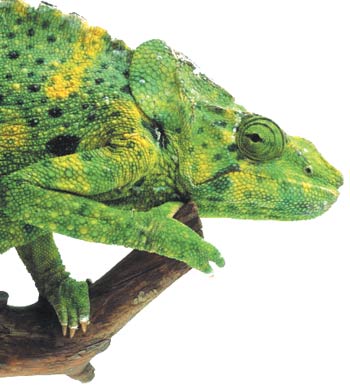
REPTILE SCALES
The scales covering the bodies of reptiles are different from bird feathers in every respect. Unlike feathers, scales do not extend beneath the skin, consisting solely of a hard layer on the surface of on animal’s skin. They bear no resemblance to bird feathers, genetically, biochemically, nor anatomically. The structure of bird feathers is far too complex to be explained by means of any evolutionary process. The well known ornithologist Alan Feduccia does not consider it probable that a tissue so well suited for flight could have emerged initially to serve another purpose (for example, insulation, as is claimed by evolutionists). As he says: “Everything about them indicates an aerodynamic function... They’re lightweight, they’re excellent airfoils, they produce high lift at low speeds, and they have a Velcro-like quality that lets them be reassembled.”95 THE COMPLEX STRUCTURE OF BIRD FEATHERS
When bird feathers are examined in detail, it is clear that they result from a very superior creation. There are even smaller filaments in every feather, as well as special hooks that attach them together. The picture shows a magnified close-up of a feather. In addition, a long, stiff tube runs along the center of the feather. From both sides of this tube emerge hundreds of barbs. These barbs, which have differing lengths and degrees of softness, give the feather its aerodynamic properties. Even more interestingly, on each barb are even smaller structures known as barbules, too small to be seen with the naked eye. On all of these barbules are tiny hooks, thanks to which the barbules are held together tightly, as if by zippers. There are 650 barbs on either side of a stork feather’s stem. Each one has 600 contraposed barbules, attached to one another by 390 hooks which, again, cling together like the two sides of a zipper. If the hooks become detached from one another, the bird has only to shake itself or groom its feathers with its beak for them to reattach. To maintain that such a complex structure evolved as the result of random mutations from reptile scales is simply a dogmatic belief, based on no scientific foundation at all. A. H. Brush, a Connecticut University professor of physiology and neurobiology, described the profound differences between reptile scales and bird feathers: Every feature from gene structure and organization, to development, morphogenesis and tissue organization is different [in feathers and scales. . . the protein structure of bird feathers and are unique among vertebrates . . . Feathers appear suddenly in the fossil record. . . . 96 This superior creation in feathers gave Charles Darwin considerable pause for thought. The magnificent beauty in peacock feathers actually made him “cold all over,” as he put it. In a letter to his friend Asa Gray dated 3 April, 1860, he wrote: . . . I remember well the time when the thought of the eye made me cold all over. 97 Origin of the Fish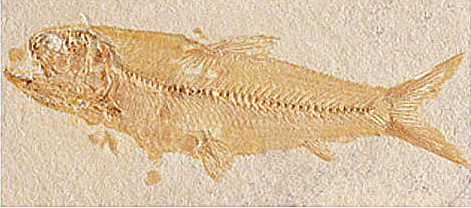
A Mesozoic Era fossil fish. Evolutionists maintain that invertebrate marine creatures that arose during the Cambrian Period developed into fish over the course of tens of millions of years. However, in the same way that Cambrian Period invertebrates had no ancestors neither are there any intermediate form to indicate any evolution between these same invertebrates and fish. (See The Cambrian Period.) Yet the very considerable transition between invertebrates—lacking skeletons and the hard parts of whose bodies are on the outside—and fish, whose hard parts act as supports in the middle of their bodies, should have left behind a vast number of fossilized intermediate forms. Yet all the different categories of fish appear suddenly in the fossil record, with no forerunners or “primitive” versions. For 140 years, evolutionists have been combing the fossil strata in their search for these imaginary intermediate forms. Although millions of invertebrate fossils and millions of fish fossils have been discovered, no one has found even a single intermediate form. In an article titled “Evolution of the Lung and the Origin of Bony Fishes: A Casual Relationship,” the evolutionist paleontologist Gerald T. Todd sets out the following questions that demonstrate evolutionists’ despair: All three subdivisions of the bony fishes first appear in the fossil record at approximately the same time . . . How did they originate? What allowed them to diverge so widely? How did they all come to have heavy armor? And why is there no trace of earlier, intermediate forms?98 The fossil record shows that just like other living classes, fish emerged suddenly and with all their different structures intact. Fish were created in a single moment, with no evolutionary process behind them. Allah is the All-Powerful Creator. 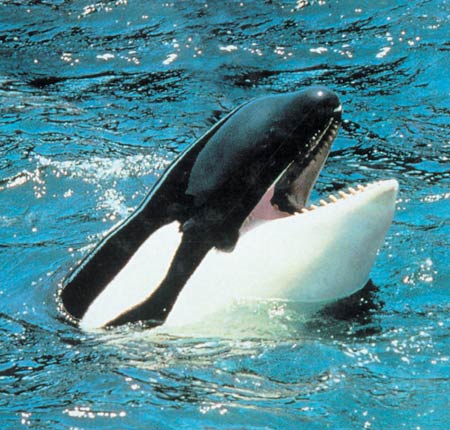
Whales have been created with the mostappro priate structures and to tally unique sensory systems for their surroundings. Origin of the FliesOne explanation offered for the origin of birds is the cursorial theory, according to which reptiles’ forearms developed into wings as they needed speed in their attempts to catch insects. This theory lacks any scientific evidence. Moreover, insects are definitely able to fly, which means that evolutionists face the problem of the origin of insects. (See The Cursorial Theory.) Flies emerge also suddenly and with their own unique structures in the fossil record. For example, a great many dragonfly fossils from the Pennsylvanian period have been discovered, all identical to present-day specimens. The interesting fact here is that both dragonflies and flies appear at the same time as species of wingless insects. This invalidates the hypothesis that wingless insects gradually developed wings. R. Wootton and C. Ellington write on the subject in an article in the book Biomechanics in Evolution: When insect fossils first appear, in the Middle and Upper Carboniferous, they are diverse and for the most part fully winged. There are a few primitively wingless forms, but no convincing intermediates are known.99 One important feature of those flies that emerge suddenly in the fossil record is their extraordinary flight techniques. Human beings cannot raise and lower their arms ten times a second, yet the average fly can flap its wings 500 times a second. Moreover, both wings beat simultaneously. The slightest irregularity in wing beats will upset the insect’s balance, but this never occurs. In an article titled “The Mechanical Design in Fly Wings,” R. Wootton writes: The better we understand the functioning of insect wings, the more subtle and beautiful their designs appear . . . Insect wings combine both in one, using components with a wide range of elastic properties, elegantly assembled to allow appropriate deformations in response to appropriate forces and to make the best possible use of the air. They have few if any technological parallels--yet.100 Origin of Flight—See TheArboreal Theory, The Cursorial Theory, and The Transition from Land to the Air Myth. Origin of the HorsesUntil recently, schematic illustrations of the evolution of horses have been a prominent proof of the theory of evolution. Today, however, many evolutionists have openly refuted the validity of this scenario. In 1980, 150 evolutionists attended a four-day meeting at the Chicago Museum of Natural History in which the problems associated with stage-by-stage evolution were discussed. At that meeting, Boyce Rensberger stated that there was no support in the fossil record for the stage-by-stage evolution of horses: The popularly told example of horse evolution, suggesting a gradual sequence of changes from four-toed fox-sized creatures living nearly 50 million years ago to today’s much larger one-toed horse, has long been known to be wrong. Instead of gradual change, fossils of each intermediate species appear fully distinct, persist unchanged, and then become extinct. Transitional forms are unknown.101 
'The evolution of horses' exhibit at the British Natural History Museum. This and the like schemas of 'the evolution of horses' are constructed basedon a totally sided point of view and by the extremely biased succes sivelining of the independent living kinds that have lived on different geographic areas in different epochs. In reality there is no scientific evidence on 'the evolution of horses'. About the “evolution of the horse” diagrams, the noted paleontologist Niles Eldredge said : There have been an awful lot of stories, some more imaginative than others, about what the nature of that history [of life] really is. The most famous example, still on exhibit downstairs, is the exhibit on horse evolution prepared perhaps fifty years ago. That has been presented as the literal truth in textbook after textbook. Now I think that that is lamentable, particularly when the people who propose those kinds of stories may themselves be aware of the speculative nature of some of that stuff. 102 In spite of the lack of any scientific support, to create this horse-evolution scenario, fossils from different species were arranged in a series from the smallest to the largest. Evolutionists claimed that this evolution occurred at different times in India, South America, North America and Europe. Various evolutionists proposed more than 20 different horse-evolution scenarios, but there is no agreement among them on the different proposed family trees. The only point they agreed on is that the 55-million-year-old dog-like creature called Eohippus (Hyracotherium) was the first so-called ancestor of horses. (See Eohippus.) However, this so-called ancestor of horses—supposed to have become extinct millions of years ago—is almost identical to a creature called the hyrax that still lives in Africa, but is no relation to a horse.103  Every day that passes, a new fossil is discovered that clearly demonstrates the discrepancy of these claims about the evolution of horses especially since Eohippus fossils have been found in the same stratum as two modern horse species, Equus nevadensis and E. occidentalis.104 This shows that horses living today lived at the same time as their supposed ancestors, proving that the so-called evolution of horses never occurred. In his book The Great Evolution Mystery, the evolutionist writer Gordon R. Taylor examined topics that Darwinism could not explain. About the mythical horse series, he writes: But perhaps the most serious weakness of Darwinism is the failure of paleontologists to find convincing phylogenies or sequences of organisms demonstrating major evolutionary change. . . The horse is often cited as the only fully worked-out example. But the fact is that the line from Eohippus to Equus is very erratic. It is alleged to show a continual increase in size, but the truth is that some variants were smaller than Eohippus [the first in the sequence], not larger. Specimens from different sources can be brought together in a convincing-looking sequence, but there is no evidence that they were actually ranged in this order in time.105 All these facts show that one of the basic proofs for the series schema of horse evolution is totally imaginary. Like other species, horses also come into existence without leaving any evolutionary ancestor in the fossil record. Origin of the Insects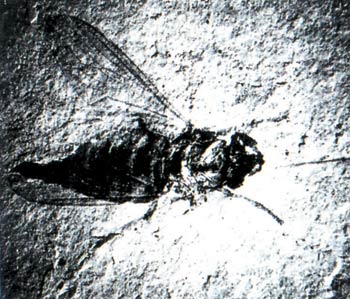
A 145-million-year-old fossilized fly. With regard to the origin of birds, evolutionist biologists claim that certain reptiles that used their front legs developed wings to catch insects and evolved into birds. According to this speculative thesis, known as the cursorial theory, the forearms of the reptiles in question gradually elongated into wings as they attempted to catch flies. (See The Cursorial Theory.) The most important question regarding this theory, which is based on no scientific findings at all, is how insects, which were already able to fly, developed their wings. Insects, flies included, represent yet another dilemma for evolutionists. 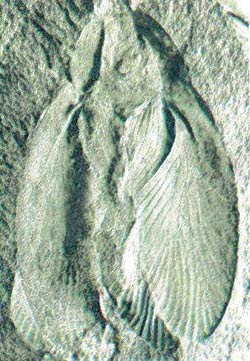
There is no difference between this 320-million-year-old fossil cockroach and modern specimens. In the classification of living things, insects represent a sub-phylum, Insecta, within the arthropod phylum (organisms with jointed legs). The oldest fossil insects belong to the Devonian Period. In the subsequent period, the Pennsylvanian, a large number of different insect species emerge suddenly. Fossilized cockroaches, for instance, appear suddenly and with the same structures they have now. Betty Faber of the American Museum of Natural History says that the cockroaches of 350 million years ago are exactly the same as those of today.106 Spiders, ticks and centipedes are not really insects, although they are generally referred to as such. At the 1983 annual meeting of the American Association for the Advancement of Science, exceedingly important fossil findings regarding these organisms were presented. The 380-million-year-old spider, tick and centipede fossils were identical to specimens alive today. One scientist who examined these findings commented that they “looked like they might have died yesterday.”107 Of course, the way that these creatures, possessing flawless designs, appeared suddenly on Earth cannot be explained in terms of evolution. (See, Origin of the Flies.) For that reason, evolutionist scientist Paul Pierre Grassé, says that “We are in the dark concerning the origin of insects.” 108 In conclusion, the sudden appearance of insects clearly confirms the fact of creation. 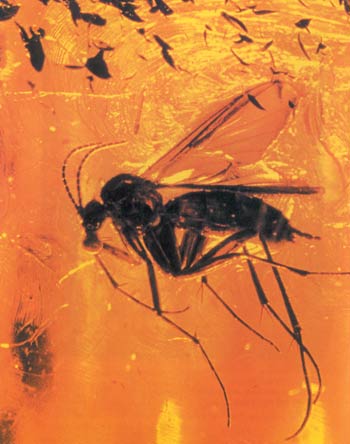
A 35-million-year-old fly preserved in amber (fossilized tree resin). This fossil, discovered near the Baltic Sea, is identical to specimens living today. Origin of Instinct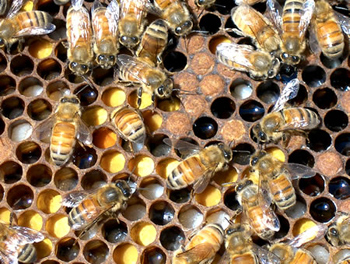 Evolutionist scientists use the word instinct is to describe certain behavior that animals possess from birth. However questions such as “How did they acquire these instincts?” “How did instinctive behavior first emerge? “how is such behavior transmitted from one generation to another?” always go unanswered. The evolutionist geneticist Gordon Rattray Taylor makes this admission regarding the dilemma represented by instincts: “When we ask ourselves how an instinctive pattern of behaviour arose in the first place and became hereditarily fixed, we are given no answer.” 109 Certain other evolutionists do not make such admissions. They try to gloss over these questions with veiled answers that do not actually mean anything at all. According to evolutionists, instincts are behaviors programmed in living things’ genes. According to this explanation, a honeybee, for example, instinctively builds its marvelous hexagonal combs that are marvels of mathematics. To put it another way, the genes of all the honeybees in the world are programmed with the instinct to construct perfect hexagonal combs. If living things perform the majority of their behaviors because they are programmed to do so, then who programmed them? Since no program can come into being of its own accord, this program must have a programmer. What evolutionists attempt to explain in terms of “instinct” or by saying “Animals have been programmed to do this,” is actually the inspiration of Allah.  Charles Darwin, who first proposed the theory of evolution, realized that animal behavior and instinct represented major threats to his theory. In The Origin of Species, he openly admitted as much, several times: Many instincts are so wonderful that their development will probably appear to the reader a difficulty sufficient to overthrow my whole theory.110 The difficulty that he experienced with regard to instincts is described in the book The Life and Letters of Charles Darwin, a collection of his correspondence collected by his son, Francis Darwin: Chapter III. of the Sketch, which concludes the first part, treats of the variations which occur in the instincts and habits of animals . . . It seems to have been placed thus early in the Essay to prevent the hasty rejection of the whole theory by a reader to whom the idea of natural selection acting on instincts might seem impossible. This is the more probable, as the Chapter on Instinct in the Origin is specially mentioned (Introduction, page 5) as one of the “most apparent and gravest difficulties on the theory.” 111 When left without an answer, evolutionists sometimes claim that animals learn some behavior by way of experience, and the best of that behavior is favored by natural selection. This good behavior is later handed on to subsequent generations by way of heredity. The logical flaws and unscientific thinking in this claim are quite clear:  1. The erroneous claim that “useful behavior is favored by natural selection.” This thesis implies that Nature is a conscious force able to distinguish between useful and harmful behaviors and of making decisions. No consciousness or force in nature is capable of this distinction. An animal itself may decide what behavior is useful, but it cannot pass this insight along through its genes alone. Only an Entity possessed of consciousness and reason—namely, the Creator of nature and the life form in question—can make that selection. Darwin himself admitted the impossibility of complex and beneficial behavior being acquired through natural selection, although he stated that he persisted in that claim despite it being nonsensical: Finally it may not be a logical deduction, but to my imagination it is far more satisfactory to look at such instincts as the young cuckoo ejecting its foster-brothers, ants making slaves . . . not as specially endowed or created instincts, but as small consequences of one general law leading to the advancement of all organic beings—namely, multiply, vary, let the strongest live and the weakest die.112 Professor Cemal Yıldırım, one of Turkey’s leading evolutionists, admits that behavior such as a mother’s love for her young cannot be explained by natural selection: Is there any possibility of accounting for a mother’s love for her young through any “blind” order [natural selection] not including a spiritual element? It is certainly hard to say that biologists [at this point Darwinists] have given a satisfactory reply to this question.113 Since these organisms, lacking any reason and foresight, have a number of miraculous features; and since it is not possible for them to have acquired these features of their own will, some power must have bestowed these features on them. The mechanism of natural selection and nature itself has no consciousness and no such spiritual features, for which reason these cannot be the source of the characteristics these creatures possess. The obvious truth is this: all living things exist by the will and under the control of Allah. For this reason, we frequently see exceedingly conscious and astonishing behavior in nature, inhabited by unconscious entities, of the kind that makes people ask. “How does this animal know how to do that?” or “How did this creature ever think of doing that?” 2. It is impossible for behavior acquired through natural selection to be transmitted genetically to subsequent generations. In the second phase of evolutionists’ claims, behavior acquired through natural selection must be genetically handed on to subsequent generations. However, such claims are full of various inconsistencies. First, , even if animals learned behavior through experience, it is impossible for subsequently acquired behavior to be passed on genetically. Learned behavior belongs uniquely to the animal that learned it. It is absolutely impossible for any learned behavior to be encoded into a living thing’s genes. Evolutionists today are still unable to resolve that same contradiction posed by Darwin 150 years ago:
3. The invalidity of the claim that instincts evolve together with living things Darwin was aware of the inconsistencies and impossibilities regarding evolutionary explanations for instincts and questioned the claim that instincts, following their acquisition, changed through natural selection: [C]an instincts be acquired and modified through natural selection? What shall we say to the instinct which leads the bee to make cells, and which has practically anticipated the discoveries of profound mathematicians? 116 This inconsistency can be made clearer by citing examples of fish, which have their own unique ways of reproducing, hunting, defense and nest-building. These characteristics have been perfectly regulated according to underwater conditions. In their mating season, some fish adhere their eggs to an undersea rock and provide them with oxygen by fanning their fins. In that case, according to evolution theory, as these fish evolved their instincts must also have undergone great changes. Indeed, their instincts would have to change almost entirely for these fish to start clearing perfect round nests, in much the same way terrestrial animals do for the protection of their eggs. In The Origin of Species, Darwin devoted some space to this criticism of his own theory: It has been objected to the foregoing view of the origin of instincts that the variations of structure and of instinct must have been simultaneous and accurately adjusted to each other, as a modification in the one without an immediate corresponding change in the other would have been fatal.” 117 As you have seen, instinctive behavior in animals cannot be explained in terms of any evolutionary process, chance, or “Mother nature”. The source of animals’ behavior lies neither in their own bodies nor in nature. Under the inspiration of Allah, all living things behave in the manner most suited to their own structures and to their surroundings. Origin of the LanguageRegarding the origin of language, there are two different views.. The first is that a human is born with a “blank slate” mind and merely learns to speak from observing those around him. However, the famous linguist Noam Chomsky has put forward a very different conclusion based on scientific facts, statistics and observations. In his view, the human mind has an innate propensity to learn language and to speak. Human beings are programmed in advance for language—in other words, they have a special built-in ability.118 The way that all babies in the world produce similar sounds shows that they are all born with a special inspiration toward speech. That human beings are created with this feature, not found in any other living thing, is Allah’s sublime artistry. Origin of the MammalsThe theory of evolution maintains that a number of living things evolved by emerging from the sea, turning into amphibians and then into reptiles, and that birds evolved from those reptiles. According to the same scenario, reptiles are the ancestors not only of birds but also of mammals. Yet there are vast structural gulfs between cold-blooded reptiles, whose bodies are covered in scales and which reproduce by laying eggs, and warm-blooded mammals, which are covered in fur and give birth to live young. One example of these gulfs involves the jaw structures of reptiles and mammals. The mammalian lower jaw consists of a single arc of bone, in which the teeth are set. A reptile’s lower jaw, on the other hand, consists of three small bones on each side. Another fundamental difference is that in the middle ears of all mammals, there are three small bones: the so-called anvil, hammer and stirrup. In contrast, in the middle ear of all reptiles, there is but a single bone. 
There is no structural difference between mammal fossils dating back tens of millions of years and specimens alive today. Moreover, these fossils appear suddenly in the Earth’s strata, with no links to earlier species. Evolutionists maintain that the reptiles’ jaw and ear gradually evolved into the mammalian jaw and ear. Of course, the question of how this came about goes unanswered. How did an ear consisting of one bone turn into one consisting of three? And how did the sense of hearing continue during this process? These other questions also go unanswered. Indeed, no intermediate form that could link reptiles to mammals has ever been found. That explains why the evolutionist paleontologist Roger Lewin was forced to say, “The transition to the first mammal . . . is still an enigma.” 119 George Gaylord Simpson, one of the 20th century’s most eminent authorities on evolution and one of the founders of neo-Darwinist theory, makes an astonishing confession from the evolutionist point of view: The most puzzling event in the history of life on earth is the change from the Mesozoic, the Age of Reptiles, to the Age of Mammals. It is as if the curtain were rung down suddenly on the stage where all the leading roles were taken by reptiles, especially dinosaurs, in great numbers and bewildering variety, and rose again immediately to reveal the same setting but an entirely new cast, a cast in which the dinosaurs do not appear at all, other reptiles are supernumeraries, and all the leading parts are played by mammals of sorts barely hinted at in the preceding acts.120 In addition, the mammals that suddenly appeared are very different from one another. The bat, horse, mouse and whale all emerged in the same geological period. It is impossible, even with the most powerful imagination, to construct an evolutionary relationship between these mammals. The evolutionist zoologist Eric Lombard writes in the journal Evolution: Those searching for specific information useful in constructing phylogenies of mammalian taxa will be disappointed. 121 All this goes to show that living things emerged on Earth suddenly and perfectly formed, as the result of no evolutionary process,. This is concrete evidence that they were created. Evolutionists, however, seek to interpret the fact that living species appeared in a particular order as an indication that they evolved. In fact, since no evolution ever took place, the order in which living things emerged is the order of creation. Fossils show that by means of a sublime and flawless creation, the Earth was filled first with marine animals and then with terrestrial ones, and that human beings came into existence after all these. Human life on Earth began suddenly and in a perfect form, contrary to the “ape-man” myth that evolutionists seek to impose on the public. Origin of the Marine MammalsWhales and dolphins are classified as mammals because, just like terrestrial mammals, they give live birth, suckle their young, breathe with lungs and are warm-blooded. But the origin of marine mammals is one of the most difficult questions facing evolutionists. Most evolutionist sources describe how the land-dwelling ancestors of seagoing mammals evolved in such a way as to move over to a marine environment as the result of a lengthy evolutionary process. According to this claim, marine mammals followed a path diametrically opposed to the transition from water to dry land, returning to a marine environment as the result of a second process of evolution. However, this theory is based on no paleontological evidence—and is also logically inconsistent. Mammals are regarded as the top rung of the evolutionary ladder. That being so, the question arises of how these creatures moved back to a marine environment. A subsequent question is that of how they adapted to that environment even better than fish. Dolphins, which are mammals and thus possess lungs, are even better adapted to their environment than fish, which breathe in water. 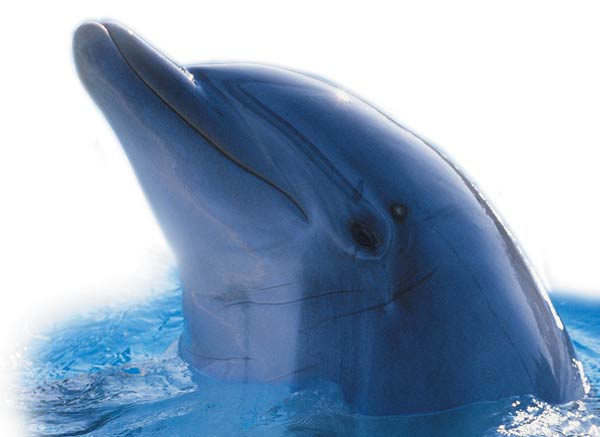 It is perfectly obvious that the imaginary evolution of marine mammals cannot be explained in terms of mutations and natural selection. One article published in GEO magazine refers to the origin of the blue whale, stating the despairing position of Darwinism on the subject: Like blue whales, the bodily structures and organs of other mammals living in the sea also resemble those of fish. Their skeletons also bear similarities to those of fish. In whales, the rear limbs that we can refer to as legs exhibited a reverse development and did not reach full growth Yet there is not the slightest information about these animals’ form changes. We have to assume that the return to the sea took place not through a long-term, slow transition as claimed by Darwinism, but in momentary leaps. Paleontologists today lack sufficient information as regards which mammal species whales are evolved from.122 It’s difficult indeed to imagine how, as the result of any evolutionary process, a small terrestrial mammal could become a whale 30 meters (98 feet) long and weighing 60 tons.. On this subject, all that Darwinists are able to do is, as in the account published in National Geographic magazine cited below, to exercise their imaginations: The whale's ascendancy to sovereign size apparently began sixty million years ago when hairy, four-legged mammals, in search of food or sanctuary, ventured into water. As eons passed, changes slowly occurred. Hind legs disappeared, front legs changed into flippers, hair gave way to a thick smooth blanket of blubber, nostrils moved to the top of the head, the tail broadened into flukes, and in the buoyant water world the body became enormous. 123 Bearing in mind the adaptations that a mammal, using lungs to breathe with, would have to undergo in order to thrive in a marine environment, it can be seen that even the word impossible fails to do justice to the situation. The absence of even one rung of the ladder in such an evolutionary transition would deny the animal the ability to survive, and bring the evolutionary process to an end. Marine Mammals and Their Unique StructuresThe adaptations that marine animals would have to undergo during a transition to a water environment can be enumerated as follows: 1. Water Conservation. Marine mammals are unable to meet their water requirements in the same way as fish do, by using salt water. They need fresh water in order to live. Although the water sources of marine animals are not well known, it is thought that they meet a large part of their water requirements by eating creatures that contain up to one-third as much salt as exists in the ocean. For marine mammals, it is of great importance to conserve as much fresh water as possible. For that reason, they possess water conservation mechanisms like that seen in camels. Like camels, marine mammals do not sweat. Their kidneys provide water for them by concentrating urine in a much better way than in humans, thus reducing water loss to a minimum. Water conservation reveals itself in even the smallest details. For example, the mother whale feeds her young with milk of a dense consistency like that of cottage cheese, and which is some tens of times more fatty than human milk. There are number of chemical reasons why the milk should have such a high fat content. As the young processes the fat it releases water as a byproduct. In this way, the mother is able to meet her young’s water requirements with a minimal water loss of her own. 2. Sight and Communication. The differences between the eyes of marine mammals and those of terrestrial life forms are surprising. On land, physical blows and dust represent threats to the eye, and for that reason, terrestrial animals have eyelids. In a marine environment, however, the main dangers are salt level, the increasing pressure when diving down to great depths, and marine currents. The creature’s eyes are positioned on the sides of the head in order to avoid direct contact with the current. In addition, marine mammals have a hard layer to protect the eye during deep dives. Since there is increasing darkness beneath a depth of 9 meters (29 feet), the mammals’ eyes have been equipped with a number of features that enable them to adapt to such a dark environment. The lens is spherical. There are many more light-sensitive rod cells than cone cells, which are sensitive to color and detail. Moreover, the eye has a special layer containing phosphorus. For these reasons, marine mammals can see very well in dark environments. 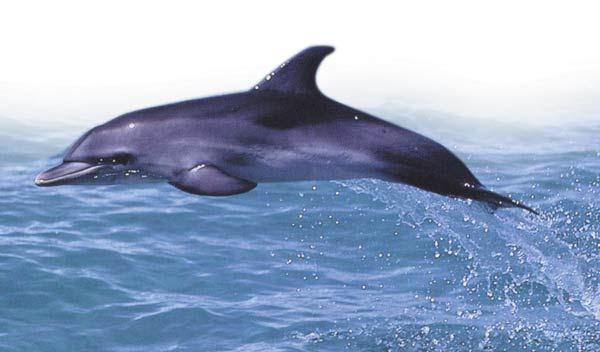 Then again, sight is not marine mammals’ primary sense. Unlike land mammals, hearing is much more important to them. Vision requires light, but many whales and dolphins hunt in dark regions under the sea thanks to a kind of natural sonar. Toothed whales in particular are able to “see” by means of the sound waves returning to them, much as a bat can. Sound waves are focused and sent to one point. The returning waves are then analyzed and interpreted in the animal’s brain. This analysis quite clearly gives the shape, size, speed and position of an object. These animals’ sonar system is exceedingly sensitive. Dolphins, for example, can detect a person’s inside diving into the water. They use sound waves for communication as well as for direction-finding. Two whales hundreds of kilometers apart can communicate by the use of sound. How do these animals produce sounds for communication and direction finding? That question is still unanswered. Among other things, however, we do know one very surprising detail: The dolphin’s skull is especially sound-proofed to protect its brain from being damaged by sound waves it emits so constantly and powerfully. There is absolutely no possibility of all these astonishing characteristics of marine mammals having arisen by way of mutation and natural selection—the theory of evolution’s only two mechanisms. Those who suggest that fish appeared in water by chance, and then later—again by chance— emerged onto dry land and evolved into amphibians, reptiles and mammals; and that these mammals then returned to the water and acquired the anatomy necessary for life there, cannot account for even one of these stages. Indeed, the fossil record shows that whales and other marine mammals appeared in the seas in a single moment and with no ancestors behind them. Edwin Colbert, an authority in the field of paleontology, describes this fact: These mammals must have had an ancient origin, for no intermediate forms are apparent in the fossil record between the whales and the ancestral Cretaceous placentals. Like the bats, the whales (using the term in a general and inclusive sense) appear suddenly in early Tertiary times, fully adapted by profound modifications of the basic mammalian structure for a highly specialized mode of life. Indeed, the whales are even more isolated with relation to other mammals than the bats; they stand quite alone. 124 As with all other fundamental living groups, no findings support the claim of marine mammals’ so-called evolution. It is impossible for them to have evolved from the land mammals that supposedly constitute their ancestors, but also, there are no transitional forms to show that such evolution ever took place. Origin of the Marine Reptiles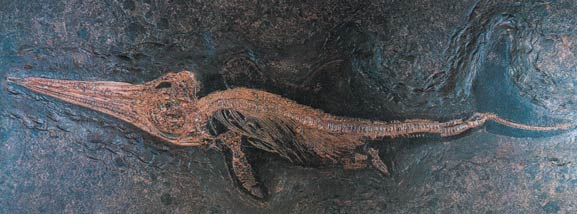
A 250-million-year old ichthyosaur fossil belonging to the species Stenopterygius The great majority of marine reptiles are now extinct, though turtles still survive as representatives of this group. The origin of these creatures cannot be explained through any evolutionist approach. The most significant known marine reptile is Ichthyosaurus. Edwin Colbert and Michael Morales admit that there can be no evolutionary explanation for these creatures’ origin: 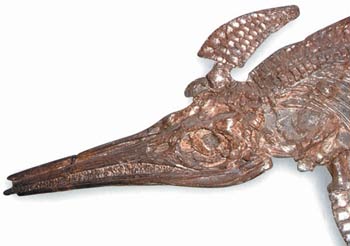
An ichthyosaur fossil, approximately 200 million years old The Ichthyosaurs, in many respects the most highly specialized of the marine reptiles, appeared in early Triassic times. Their advent into the geologic history of the reptiles was sudden and dramatic; there are no clues in pre-Triassic sediments as to the possible ancestors of the Ichthyosaurs . . . The basic problem of Ichthyosaur relationships is that no conclusive evidence can be found for linking these reptiles with any other reptilian order. 125 Alfred Romer, another expert on vertebrate history, writes: No earlier forms [of ichthyosaurs] are known. The peculiarities of ichthyosaur structure would seemingly require a long time for their development and hence a very early origin for the group, but there are no known Permian reptiles antecedent to them. 126 In short, all the different marine reptiles appeared on Earth separately, with no evolutionary relationship among them. This constitutes manifest scientific proof that all living things are created. Origin of the Quadrupeds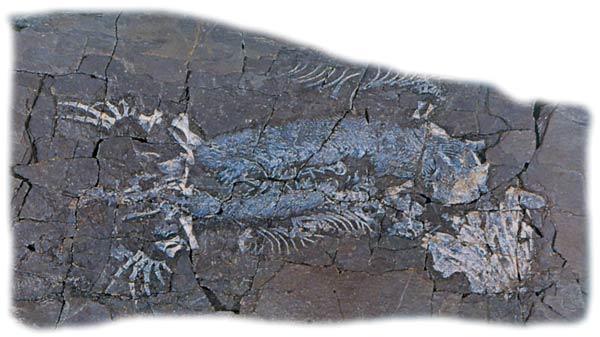
Tetrapod fossil Quadrupeds (or tetrapods) is the name given to four-footed land-dwelling vertebrates. This general classification includes amphibians, reptiles and mammals. The Darwinists’ explanation is that quadrupeds evolved from fish. However, this claim is physiologically and anatomically untenable—and also, has no foundation in the fossil record. In order for a fish to adapt to life on dry land, it would have to undergo tremendous changes in its respiratory system, excretory system and skeletal structure. Its gills would have to be supplemented by lungs; its fins would have to acquire sturdiness capable of bearing the weight of its body. Kidneys to dispose of bodily wastes would need to form, and its skin would have to acquire a structure to prevent loss of moisture. So long as all these changes fail to take place, a fish could survive on dry land for only a few minutes. (See also The Transition from Water to Land Thesis.) Origin of PhotosynthesisPhotosynthesis is a major factor in sustaining life on Earth. Were it not for photosynthesis, there would be no plants, and if there were no plants there would be little oxygen—and no animals and human beings. This chemical reaction, which cannot be replicated in any laboratory, represents one of the basic conditions for life. In addition, there is a total balance between the photosynthesis performed by plants and the energy consumed by animals and human beings. Plants provide us with glucose and oxygen. In our cells, we combine that glucose with oxygen and oxidize it, thus releasing and using the solar energy that plants originally used to form glucose. 
Plant cells perform photosynthesis, a process that cannot be carried out in any laboratory. Thanks to an organelle in the cell known as the chloroplast, plants use water, carbon dioxide and the energy from sunlight to manufacture starch. This nutrient is the first link in the Earth’s food chain and the source of nourishment for all living things on Earth. The details of this highly complex process have still not been fully deciphered. What we’re actually doing is reversing the process of photosynthesis. As a result, carbon dioxide is given off as a waste product, which we release into the atmosphere through our lungs. This carbon dioxide is then used again by plants in further photosynthesis. And so this immaculate cycle continues. As you see, photosynthesis is one of the most fundamental processes of life on Earth. Thanks to the chloroplasts inside them, plant cells produce starch by combining water and carbon dioxide, with the energy from sunlight. Animals, unable to produce their own nutrients, use the starch that comes from plants. For that reason, photosynthesis is essential for any complex life forms—yet photosynthesis’s highly complex process is not yet fully understood. Modern technology has not even unraveled its details, let alone been able to replicate it. According to the theory of evolution, this complex process is a result of natural events. The evolutionist hypothesis is that in order to perform photosynthesis, plant cells swallowed photosynthesizing bacteria and turned them into chloroplasts, much as modern-day lichens are a symbiotic combination of algae and fungi. However, the question of how bacteria learned to carry out such a complex process as photosynthesis heads the list of those that the evolutionary scenario leaves unanswered.  Evolutionist sources say that this process, which humans even with all their advanced technology and knowledge cannot perform, was in some way discovered by bacteria. These accounts are no different from fairy tales and are of absolutely no scientific worth. Those who look at the subject in any great detail have to admit that photosynthesis constitutes a major dilemma for the theory of evolution. For instance, evolutionist Professor Ali Demirsoy makes the following admission: “Photosynthesis is a highly complex process, and it would appear impossible for it to appear in an organelle inside a cell—because it is impossible for all the phases to appear at once, and meaningless for them to do so one by one.” 127 The German biologist Hoimar von Ditfurth states that photosynthesis is a process that could not be learned by a cell that lacked such ability in the first place: No cell possesses the literal ability to “learn” a biological process. A cell is not in the position to function during the birth of a process such as respiration or photosynthesis and to discharge this during a subsequent vital process, and it is impossible for it to acquire the ability to do so. 128 Since photosynthesis cannot develop as the result of chance and cannot be learned by any cell, then the first plant cell on Earth must have already possessed this ability. In other words, Allah created plants together with their ability to make photosynthesis. Origin of the Plant CellsPlant and animals are composed of a type of cell known as eukaryotic. Eukaryotic cells’ main distinguishing features are that they possess a nucleus, inside which is found the DNA molecule that encodes genetic information. Some single-celled organisms such as bacteria, on the other hand, have no cell nuclei, and their DNA molecules are in a free state inside the cell. (See Bacteria.) This second cell type is known as prokaryotic—an ideal cell structure for bacteria, because plasmid transfer (the transfer of DNA from cell to cell)— an exceedingly important process from the point of view of bacteria populations—is made possible thanks to DNA being free within the prokaryotic cell. Since the theory of evolution is obliged to arrange life from the primitive to the complex, it assumes that prokaryotes are primitive cells, and that eukaryotes evolved from them. 
Plants represent the foundation of life on Earth. Because they produce food for animals as well as providing the atmospheric oxygen they need to breathe, they represent an indispensable precondition for life. Before addressing the invalidity of this claim, it’s useful to state that prokaryotic cells are not primitive at all. A bacterium has almost 2,000 genes, and each gene contains up to 1,000 letters of genetic code. This means that the information in a bacterium’s DNA is at least 2 million “letters” long. Accordingly, the information contained in the DNA of a single bacterium is equivalent to 20 volumes of 100,000 words each.129 Any change in this encoded information may damage the bacterium’s entire operating system, spelling death for the bacterium. In addition to DNA’s sensitive structure that withstands random changes, the lack of any intermediate form between bacteria and eukaryotic cells totally invalidates any claim of evolution. The Turkish evolutionist Professor Ali Demirsoy admits that the scenario of bacteria cells evolving into eukaryotic cells—from which more complex life forms then emerged—is invalid: One of the most difficult phases to account for in evolution is the scientific explanation of how complex cells with organelles came into being from these primitive organisms. In fact, no transitional form between these two forms has ever been found. Single-celled and multi-celled organisms fully possess this complex structure, and no group or organism with simpler organelles or which is more primitive than either of these has ever been encountered. In other words, the organelles they possess emerged fully developed. There are no simple and primitive forms.130 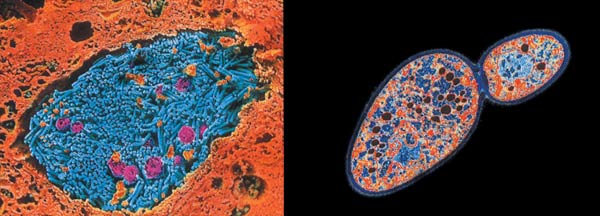
There is no scientific basis to the evolutionist hypothesis that prokaryotic cells (left) gradually turned in eukaryotic ones (right). Bearing in mind the enormous structural differences between the bacterium cell and plant cells, the impossibility of any such transition becomes crystal-clear: 
A 25-million-year-old plant fossil with the same structure as plants living today.
Messenger RNA performs a function that is vital to the cell’s survival. However, although messenger RNA plays the same essential role in both eukaryotic and prokaryotic cells, it has a different biochemical structure in each. Darnell writes on this subject in an article in Science magazine: The differences in the biochemistry of messenger RNA formation in eukaryotes compared to prokaryotes are so profound as to suggest that sequential prokaryotic to eukaryotic cell evolution seems unlikely.133 The enormous structural differences between bacteria and plant cells, of which we have listed a few examples, represent a major impasse for evolutionist biologists. Some bacteria and plant cells do have some features in common, but these structures are generally very different from one another. These differences, and the impossibility of any functional intermediate form, make it impossible for the plant cell to have evolved from a bacterium. Professor Demirsoy actually admits this: “Complex cells never developed from primitive cells by a process of evolution.” 134 Origin of ReptilesCreatures such as dinosaurs, lizards, tortoises and crocodiles all belong to the reptile family. Reptiles possess unique characteristics: They are all covered in scales. They are cold-blooded and cannot produce their own body heat, for which reason they need to warm their bodies in the Sun every day. Their young hatch from eggs. Evolution theory faces another major dilemma in explaining the origin of these creatures. Darwinists claim that reptiles evolved from amphibians, yet no concrete evidence supports this. On the contrary, a comparison of reptiles and amphibians shows enormous physiological differences between the two groups, and that any half-reptile, half-amphibian would stand no chance of survival. 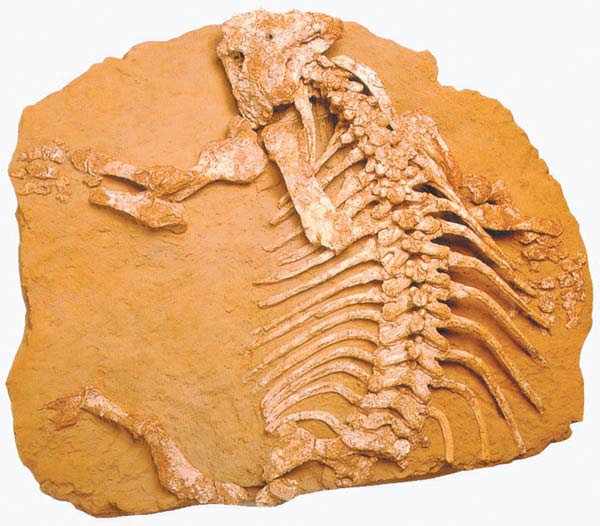
Seymouria fossil One reason concerns the two groups’ different egg structures. Amphibians deposit their eggs in water, and they are ideally suited to aqueous development. These eggs are highly porous, they have a transparent membrane and a jelly-like consistency. Reptiles, on the other hand, lay their eggs on land, and their eggs are ideally suited to dry conditions. The hard shell of the reptile egg, known as an amniotic egg, contains an air sac, and is impermeable to water. The water needed by the young is contained inside the egg until it hatches. Were amphibians to deposit their eggs on land, they would soon dry out and the embryos inside would die. This is a point that the evolution theory, which maintains that reptiles gradually evolved from amphibians, cannot explain. To begin life on dry land, the amphibian’s egg would have to become an amniotic one within a single generation. This could hardly occur through mutation and natural selection, the two suggested mechanisms of evolution. On the other hand, the fossil record also removes the possibility of an evolutionary origin for reptiles. In an article, “Problems of the Origin of Reptiles,” the well-known evolutionist paleontologist Lewis L. Carroll admits as much: Unfortunately, not a single specimen of an appropriate reptilian ancestor is known prior to the appearance of true reptiles. The absence of such ancestral forms leaves many problems of the amphibian-reptilian transition unanswered. 135 Robert L. Carroll, regarded as an authority on vertebrate paleontology, accepts that “The early amniotes are sufficiently distinct from all Paleozoic amphibians that their specific ancestry has not been established.”136 Carroll also makes these comments in his book: When they first appear in the fossil record, both frogs and salamanders appear essentially modern in their skeletal anatomy. . . Despite these similarities, frogs, salamanders, and caecilians are very different from one another in skeletal structure and ways of life, both now and throughout their known fossil record . . . we have found no fossil evidence of any possible antecedents that possessed the specialized features common to all three modern orders.137 The most important creature that evolutionists have so far sought to portray as the “ancestor of reptiles” is the fossil amphibian Seymouria. Yet the discovery that reptiles were alive 30 million years before Seymouria’s appearance revealed that this cannot be an intermediate species. (See Seymouria.) It is of course impossible for “the forerunner of reptiles” to have first appeared long after them. The scientific facts show that reptiles emerged on Earth not through the gradual change maintained by the theory of evolution, but suddenly, with no antecedents. 
Allah created every animal from water. Some of them go on their bellies, some of them on two legs, and some on four. Allah creates whatever He wills. Allah has power over all things.(Surat an Nur, 45) Origin of Species, TheIn 1859, Charles Darwin published a book called The Origin of Species, By Means of Natural Selection or, The Preservation of Favored Races in The Struggle for Life. In this book, Darwin added his own errors of logic to Lamarck’s theory and advanced his thesis of natural selection. (See Natural Selection and Lamarckism.) In his book, which he described as a “long argument,” Darwin claimed that all living things on Earth shared a common origin and that living things descended from one another by way of natural selection. In addition, Darwin said that only those best able to adapt to their environment handed on their characteristics to subsequent generations. Over the course of time, these beneficial changes would accumulate, and living things would turn into other forms of life very different from their ancestral species. Man was the most advanced product of so-called natural selection. Darwin thought he had found the origin of species: The origin of any one species was another, earlier species. Darwin’s greatest difficulty was that paleontology, the science he hoped would provide answers to the problems facing his theory, would in fact only make them worse. To be fair, he was aware of at least some of these problems. In the appendix to his book, titled “Difficulties of the Theory,” he even admitted them. However, the answers he supplied to these problems lacked any scientific validity. The American physicist Lipson comments on Darwin’s “difficulties”: On reading The Origin of Species, I found that Darwin was much less sure of himself than he is often represented to be; the chapter entitled “Difficulties of the Theory,” for example, shows considerable self-doubt. As a physicist, I was particularly intrigued by his comments on how the eye would have arisen. 138 Darwin hoped that as scientific research progressed, these difficulties would be resolved. On the contrary, however, later scientific findings only worsened them. Origin of Turtles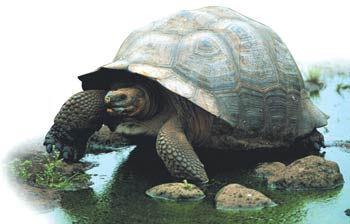 Turtles, members of the reptile family, emerge suddenly in the fossil record together with their unique shells. As evolutionist sources put it, “Unfortunately, the origin of this highly successful order is obscured by the lack of early fossils, although turtles leave more and better fossil remains than do other vertebrates. By the middle of the Triassic Period (about 200,000,000 years ago), turtles were numerous and in possession of basic turtle characteristics. . . Intermediates between turtles and cotylosaurs, the primitive reptiles from which turtles probably sprang, are entirely lacking.” 139 Robert Carroll, an expert on vertebrate paleontology, states that “important transitions and radiations [are] still poorly known.”140 This living class appeared suddenly on Earth, which represents evidence that they were created by Allah. 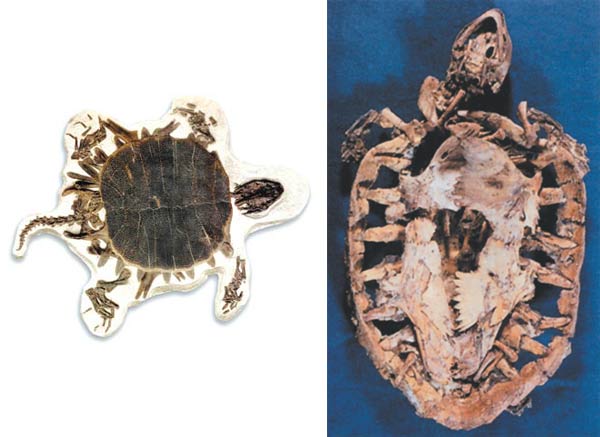
Right Picture: Remains of the oldest known turtle. Found in Brazil, this 110-million-year-old fossil is indistinguishable from present-day specimens. Origin of VertebratesOne of the phyla that emerged suddenly in the Cambrian period is the phylum Chordata, These are a sub-class of vertebrates, with a central nervous system. Vertebrates are divided into such basic classes as fish, amphibians, reptiles, birds and mammals. Since evolutionist paleontologists regard every living phylum as the evolutionary continuation of another, they claim that the Chordata evolved from another, invertebrate phylum. However, like all phyla, members of the phylum Chordata appeared suddenly in the Cambrian Period, which invalidates that theory right from the outset. The oldest member of the phylum, a sea creature with a long body rather resembling a worm’s at first glance is, known as Pikaia. 141 It emerged at exactly the same time as species in all the other phyla that could be proposed as its ancestor, and with no previous intermediate form. In his book Vertebrate Animals, the evolutionist biologist Professor Mustafa Kuru refers to the absence of such an intermediate form: “There is no doubt that the Chordata formed from invertebrate animals. However, the absence of any fossil that might shed light on the passage between invertebrates and Chordata has caused many hypotheses on this subject to be jettisoned.” 142 
The conjectural anatomy of Pikaia, the oldest known chordate If there is no intermediate form, how can one say that there is “no doubt” about this evolution? Blindly accepting a hypothesis with no evidence to support it is dogmatic rather than scientific. Indeed, after going into a lengthy account of evolutionist assumptions regarding the origin of vertebrates, Professor Kuru once again has to admit that no evidence is available at all: “The views regarding the origin and evolution of the Chordata expressed above have always been treated with suspicion, since they are not based on a fossil record.” 143 Evolutionist biologists sometimes offer the following sort of rationale: There is no fossil record regarding the origin of the Chordata and other vertebrates because invertebrates are soft-tissued and therefore leave no fossil traces behind. But in fact, there are many fossil invertebrate remains. All the living things from the Cambrian Period are invertebrates, and they have left tens of thousands of fossils behind them. Many fossils of soft-tissued creatures have been found in the Burgess Shale bed in Canada; scientists think that in regions such as Burgess Shale living things were quickly covered in layers of mud with low oxygen content and thus fossilized without their soft tissues having broken down.144 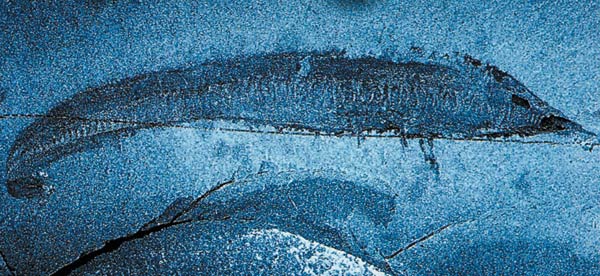
The oldest chordate Pikaia fossil to appear in the Cambrian Period The theory of evolution hypothesizes that Chordata such as Pikaia gradually turned into fish. However, just as there is no intermediate form to support the idea of the evolution of Chordata, so there are none to support that of the evolution of fish. On the contrary, all the different categories of fish appear suddenly in the fossil record and with no ancestors preceding them. There are millions of invertebrate fossils, but nobody has ever found a single intermediate-form fossil. Fish dating back to the Cambrian Period, especially those discovered in China such as Haikouichthys and Myllokunmingia, invalidate evolutionist claims of gradual development. Philippe Janvier, a palaeontologist from the Museum of Natural History in Paris, states that these life forms found in China were “definitely vertebrates” and sets out their importance: It’s important because up to now the vertebrates were absent from the big bang of life, as we call it—that is, the great early Cambrian explosion, where all the major animal groups appeared suddenly in the fossil record . . . It is practically certain that these are vertebrates.145 Origin of VirusesSome evolutionists maintain that viruses represent the biological beginning of life: When we look at the pre-cellular stages of life, we see evolution here, too. The first, most primitive forms of biological organisms are not cells, but viruses.146 On the one hand, while evolutionists seek to account for the origin of life in terms of viruses, they also say that viruses cannot represent the foundation of life. This impossibility is mentioned in a number of evolutionist sources:
Viruses multiply as parasites in the cells of a foreign organism. They have no metabolisms beyond those of the host cells. Since viruses have no metabolisms and ability to be stimulated they do not possess the features of independence unique to life, and are therefore not truly alive, in the usual sense. Viruses are known as virions when they are still outside the cell. Virions are not alive. Only two of the key processes in living things are found in viruses: replication and mutation. Viruses cannot perform these functions independently outside the cell, in their form as virions. They need complete organisms in order to “come to life.”.148 
A virus lives as a parasite in the cells of a foreign organism. Viruses have no metabolisms of their own outside the host cell. The diagram above shows how a virus takes over a cell. It first attaches itself to the cell, then injects it with its own DNA. The cell is thus forced into copying the virus. Eventually, the cell explodes and the new virus particles are released. As you can see, viruses cannot be regarded as a pre-life stage, because they can perform such key stages as replication and mutation only in the cells of the organisms they inhabit. Viruses are unable to survive in the absence of a complete organism. For that reason, there can be no question of their constituting a preliminary stage for bacteria, for example. Professor Ali Demirsoy, a Turkish expert on evolution, refers to the invalidity of the claims regarding the origins of viruses:
As you can see from these comments, viruses do not represent the beginning of life. Even evolutionist biologists point the living organisms as the origin of viruses. Origins of Bipedalism (Walking Upright)Human beings walk upright on two legs in a way not encountered in any other life form. (See Bipedalism,) Some other animals possess a limited ability to walk on two legs. Mammals such as the bear and monkey can move on their hind legs for short periods of time, such as when they’re reaching for something to eat). However, they have stooped skeletons and normally walk on four legs. According to the classifications made in the imaginary human family tree, it is claimed that apes classified under the names Australopithecus and Homo habilis walked upright. However, through research into their fossil skeletons in question by a great number of scientists, the invalidity of these claims has been revealed. The claim of bipedalism is one that evolutionist paleontologists such as Richard Leakey and Donald Johanson have supported for decades. Wide-ranging research into Australopithecus specimens by two world famous anatomists, Lord Solly Zuckerman of Britain and Professor Charles Oxnard of the USA, showed that these beings were not bipedal, but moved in the same way as present-day apes. Despite being an evolutionist himself, Lord Zuckerman, who for 15 years examined the bones of these creatures with a team consisting of five experts, backed by the British government, concluded that Australopithecus was an ordinary species of ape and very definitely did not walk upright.150 Professor Oxnard, another evolutionist anatomist well known for his research on this subject, compares the Australopithecus skeleton to that of modern orangutans.151 Finally in 1994, Liverpool University’s Fred Spoor and his team carried out wide-ranging studies in order to arrive at a definitive conclusion regarding the Australopithecus skeleton. During that research, the inner ear structures of Australopithecus fossils were examined. An organ known as the cochlea determines the body’s position relative to the ground in the inner ears of human beings and other complex life forms. That organ’s function is similar to the bubble level used to maintain level surfaces by carpenters.. In order to determine whether the creatures portrayed as ancestors of man walked upright, Fred Spoor investigated this particular organ. The comparison analyses made on the balance centers revealed that apes classified as Homo habilis did not walk upright, but were bent forward.152 Origin of WhalesWhales and dolphins comprise a group known as marine mammals Just like mammals on land, they give birth to their young, suckle them, use lungs to breathe and warm their own bodies. The origin of marine mammals is one of the most difficult subjects for evolutionists to account for. Most evolutionist sources suggest that their forerunners lived on dry land, evolved as the result of a lengthy evolutionary process, in such a way as to return to a marine environment. According to this claim, marine mammals followed a path which was the exact opposite of the supposed transition from water to land, via a second process of evolution. However, this theory is based upon no paleontological findings, and is also logically inconsistent. Mammals are regarded as the creatures at the top of the evolutionary ladder. That being so, it is very hard to explain why these animals reverted to a marine environment. The next question is, how did these animals adapt to the marine environment even better than fish? Because creatures such as killer whales, which are mammals and therefore have lungs, exhibit an even more perfect adaptation to their environment than fish, which actually do breathe in water. In recent years, various fossils have been suggested as solution to this dilemma, but in fact benefit the theory of evolution not at all. The first of these fossils is Pakicetus inachus, extinct mammal first discovered in 1983. The finder of the first specimen, Philip D. Gingerich and his colleagues had no qualms about claiming it to be a primitive whale, even though they had discovered only a skull. However, the fossil had not the slightest connection to whales in any shape or form. The skeleton had a four-footed structure, resembling that of modern wolves. The region where the fossil was discovered contained seams of oxidized iron as well as fossils of such terrestrial animals as snails, tortoises and crocodiles. In other words, its environment had been dry land, not a marine bed. So why was this quadruped land dweller deemed to be a primitive whale? The answer is supplied in National Geographic magazine, an evolutionist publication: Subtle clues in combination—the arrangement of cusps on the molar teeth, a folding in a bone of the middle ear, and the positioning of the ear bones within the skull—are absent in other land mammals.153 However, these features represent no evidence for constructing a relationship between Pakicetus and fish:
In an article titled “The Overselling of Whale Evolution,” the science writer Ashby L. Camp describes the invalidity of the claim that the Mesonychids,of which land mammals such as Pakicetus are a part, are the ancestors of Archaeocetes, the extinct whales: The reason evolutionists are confident that mesonychids gave rise to archaeocetes, despite the inability to identify any species in the actual lineage, is that known mesonychids and archaeocetes have some similarities. These similarities, however, are not sufficient to make the case for ancestry, especially in light of the vast differences. The subjective nature of such comparisons is evident from the fact so many groups of mammals and even reptiles have been suggested as ancestral to whales. 154 Pakicetus is followed in the evolutionary tree by Ambulocetus natans. This fossil, first announced in an article published in Science magazine in 1994, is a terrestrial animal that evolutionists have attempted to force into a whale mould. The name Ambulocetus natans is a combination of the Latin words ambulare (to walk), cetus (whale) and natans (swimming), and thus means “a swimming and walking whale.” Obviously, this animal walked, because like all terrestrial mammals, it had four feet, and even wide claws on its feet and paws on its hind legs. Apart from evolutionist preconceptions, however, there is absolutely no foundation, for the idea that the animal swam in water or that it lived both on land and in water, as hippos and alligators do. In fact, there is no evidence that either Pakicetus or Ambulocetus were related to whales in any way. They are merely potential ancestors which evolutionists, obliged to find a terrestrial ancestor for marine mammals as required by their theory, have suggested on the basis of various limited similarities. No evidence shows that these creatures were related to the marine mammals that emerge in the fossil record in a geological period very soon after.. A number of true marine mammals are listed in the fictitious evolutionary tree after Pakicetus and Ambulocetus: Archaeocetes (“ancient whale”) species such as Procetus and Rhodcetus. These creatures are extinct mammals that genuinely did live in water, as you shall see in subsequent sections. However, there are considerable anatomical differences between Pakicetus and Ambulocetus and these marine animals:
In conclusion, it is clear that marine mammals appeared with all their unique structures and with no intermediate form between them and terrestrial mammals. Robert Carroll admits this, albeit reluctantly and in evolutionist language, that there is no chain of evolution here.: It is not possible to identify a sequence of mesonychids leading directly to whales. 156 Some rather more unbiased scientists, on the other hand, openly admit that the animals that evolutionist sources refer to as “walking whales” are actually a completely separate group and have nothing to do with true whales. The Russian scientist G. A. Mchedlidze, a well-known expert on whales, disagrees with the description of Pakicetus, Ambulocetus natans and similar quadrupeds as possible ancestors of the whale, and regards them as a completely isolated group.157 This summarizes the invalidity of the evolutionist claim that marine mammals evolved from terrestrial life forms. Scientific findings show no link between marine mammals and the two land mammals (Pakicetus and Ambulocetus natans) that evolutionists place right at the beginning of this scenario. In the remaining part of the scenario, the theory of evolution is also at an impasse. The theory seeks to establish a family relationship between the extinct, genuine marine mammal known as Archaeocetes (“archaic whale”) and living dolphins and whales. The fact is that experts in the field think differently. The evolutionist paleontologist Barbara J. Stahl writes: The serpentine form of the body and the peculiar serrated cheek teeth make it plain that these archaeocetes [i.e., Basilosaurus and related creatures] could not possibly have been ancestral to any of the modern whales. 158 With regard to the origin of marine mammals, the evolutionist scenario is also contradicted by molecular biology’s findings. The classic evolutionist scenario hypothesizes that the two major whale groups, in order words toothed whales (Odontoceti) and baleen whales (Mysticeti), evolved from a common ancestor. However, Michel C. Milinkovitch of Brussels University opposed this view with a new theory, emphasizing that that hypothesis, constructed on anatomical similarities, and was invalidated by molecular discoveries: Evolutionary relationships among the major groups of cetaceans is more problematic since morphological and molecular analyses reach very different conclusions. Indeed, based on the conventional interpretation of the morphological and behavioral data set, the echolocating toothed whales (about 67 species) and the filter-feeding baleen whales (10 species) are considered as two distinct monophyletic groups . . . On the other hand, phylogenetic analysis of DNA... and amino acid. . . sequences contradict this long-accepted taxonomic division. One group of toothed whales, the sperm whales, appears to be more closely related to the morphologically highly divergent baleen whales than to other odontocetes.159 In short, marine mammals all refute the imaginary family tree in which evolutionists seek to locate them. Origin of the WingsHow could the immaculate structure of wings have emerged as the result of consecutive random mutations? That question is one that evolutionists are unable to answer. They are totally unable to explain how a reptile’s front legs could have turned into a flawless wings as the result of successive defects (mutations) arising in its genes. The Turkish evolutionist and scientist Engin Korur describes the impossibility of wings evolving: The common feature of eyes and wings is that they can only fulfill their tasks in the event that they are fully formed. To put it another way, one cannot see with a deficient eye, nor fly with half a wing. How these organs came into being has remained as one of the secrets of nature that has not yet been unraveled.160 Orthogenesis Muddle, The (Directed Selection)Orthogenesis is an old thesis that is no longer accepted even by theory of evolution’s own adherents. This thesis assumes that living things evolved not according to environmental conditions, but solely according to their own genetic structures. According to the orthogenetic view, a kind of internal program leads living things to evolve in a particular way. This view also led to orthogenesis being known as the predetermination theory. This hypothesis, based on no scientific evidence whatsoever, lost all credence in the second half of the 20th century. Ota Benga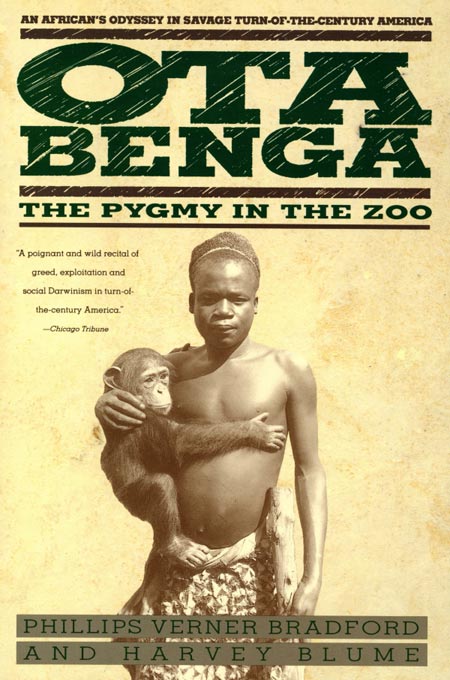 After Darwin claimed that human beings evolved from ape-like creatures in his book The Descent of Man, a search began for fossils to back up his theory. Some evolutionists, however, believed that half-man, half-ape creatures could be found not only in the fossil record, but still living in various parts of the world. In the early part of the 20th century, this search for living intermediate forms led to various shameful actions. One of these involved the pygmy Ota Benga. He was captured in Congo in 1904 by an evolutionist researcher named Samuel Verner. Ota Benga, whose name meant friend in his own language, was married with two children. Yet he was chained, placed in a cage like an animal and transported to the U.S.A. There, evolutionist scientists put him in a cage with various apes at the St. Louis World Fair and exhibited him as the closest intermediate form to man. Two years later they took him to the Bronx Zoo in New York and exhibited him together with a few chimpanzees, a gorilla named Dinah and an orangutan called Dohung as man’s oldest ancestors. The evolutionist director of the zoo, Dr. William T. Hornaday, made long speeches about how honored he was to own this intermediate form, and visitors to the zoo treated Ota Benga like any other animal. Unable to withstand the treatment he was subjected to, Ota Benga committed suicide.161 An article published in The New York Times at the time described visitors’ behavior: 40,000 visitors roamed the New York Zoological Park… the sudden surge of interest… was entirely attributable to Ota Benga. The crowds were so enormous that a police officer was assigned full-time to guard Ota (the zoo claimed this was to protect him) as he was “always in danger of being grabbed, yanked, poked, and pulled to pieces by the mob.” 162 The 17 September 1906 edition of The New York Times emphasized that although this was all done in order to prove evolution; it was actually a great injustice and act of cruelty:
The New York Times also covered the way in which Ota Benga was put on display in the zoo in order to demonstrate evolution. The defense issued by the Darwinist zoo director was lacking in all conscience: The exhibition of an African pygmy in the same cage with an orang outang at the New York Zoological Park last week stirred up considerable criticism. Some persons declared it was an attempt on the part of Director Hornaday to demonstrate a close relationship between Negroes and monkeys. Dr. Hornaday denied this. “If the little fellow is in a cage,” said Dr. Hornaday, “it is because he is most comfortable there, and because we are at a loss to know what else to do with him. He is in no sense a prisoner, except that no one would say it was wise to allow him to wander around the city without some one having an eye on him.” 164 Ota Benga’s being put on show in the zoo alongside gorillas, just like an animal, made many people uneasy. Some organizations declared that Ota Benga was a human being and that such treatment was very cruel, and applied to the authorities to put an end to the situation. One of these applications appeared in the 12 September 1906 edition of the New York Globe:
NOTES
74. E.H. Colbert, M. Morales, Evolution of the Vertebrates, John Wiley and Sons, New York, 1955, p. 303.
75.E.H. Colbert, M. Morales, Eli C. Minkoff, Evolution of the Vertebrates, Wiley-Liss; 5 Sub edition, p.193.
76.A. S. Romer, Vertebrate Paleontology, 3rd ed., Chicago: Chicago University Press, 1966, p. 120.
77. Prof. Dr. Ali Demirsoy, Kalıtım ve Evrim, p. 80.
78. Hoimar Von Ditfurth, Dinozorların Sessiz Gecesi 2, Alan Yayıncılık, Nov 1996, Istanbul: Çev: Veysel Atayman, pp. 60-61.
79. Mahlon B. Hoagland, Hayatın Kökleri, Tübitak Publishing, 8th edition, p. 25.
80.Prof.Dr. Ali Demirsoy, Kalıtım ve Evrim, Ankara: Meteksan Publishing, p. 79.
81. Prof. Dr. İlhami Kiziroğlu, Genel Biyoloji, (General Biology) Istanbul:.Desen Publications,
82. Robert A. Wallace, Gerald P. Sanders, Robert J. Ferl, Biology, The Science of Life, Harper Collins College Publishers, p. 283.
83. Darnell, “Implications of RNA-RNA Splicing in Evolution of Eukaryotic Cells,” Science, Vol. 202, 1978, p. 1257.
84. Prof. Dr. Ali Demirsoy, Kalıtım ve Evrim, p. 79.
85. Lewis L. Carroll, “Problems of the Origin of Reptiles,” Biological Reviews of the Cambridge Philosophical Society, Vol. 44, p. 393.
86.Robert L. Carroll, Vertebrate Paleontology and Evolution, New York: W. H. Freeman and Co., 1988, p. 198.
88. H. S. Lipson, “A Physicist's View of Darwin's Theory,” Evolution Trends in Plants, Vol. 2, No. 1, 1988, p. 6.
89. Encyclopaedia Britannica Online, “Turtle--Origin and Evolution.”
90. Robert L. Carroll, Patterns and Processes of Vertebrate Evolution, Cambridge University Press, 1997, pp. 296-97.
91.Douglas Palmer, The Atlas of the Prehistoric World, Discovery Channel, London: Marshall Publishing, 1999, p. 66.
92. Mustafa Kuru, Omurgalı Hayvanlar, Ankara: Gazi Üniversitesi Yayınları, , 1996, p. 21.
94. Douglas Palmer, The Atlas of the Prehistoric World, Discovery Channel, p. 6.
95. Richard Monastersky, “Waking Up to the Dawn of Vertebrates,” Science News, Vol. 156, No. 19, 6 November 1999, p. 292
96. Prof. Dr. Muammer Bilge, Hücre Bilimi, p. 59.
97. Prof. Dr. Ali Demirsoy, Kalıtım ve Evrim, pp.65, 72.
98. M. Yılmaz Öner, Canlıların Diyalektiği ve Yeni Evrim Teorisi, pp. 84-89
99. Prof. Dr. Ali Demirsoy, Kalıtım ve Evrim, p. 73.
100. Solly Zuckerman, Beyond The Ivory Tower, New York: Toplinger Publications, 1970, pp.75-94.
101. Charles E. Oxnard, “The Place of Australopithecines in Human Evolution: Grounds for Doubt,” Nature, Vol 258, p. 389.
102. Fred Spoor, Bernard Wood, Frans Zonneveld, “Implication of Early Hominid Labryntine Morphology for Evolution of Human Bipedal Locomotion,” Nature, Vol. 369, June 23, 1994, pp. 645-648.
103. “Evolution of Whales,” National Geographic, November 2001, pp. 64-77.
104. Ashby L. Camp, “The Overselling of Whale Evolution,” Creation Matters, May/June 1998, http://www.trueorigin.org/whales.asp
105.“Evolution of Whales,” National Geographic, pp. 64-77.
106. Robert L. Carroll, Patterns and Processes of Vertebrate Evolution, Cambridge University Press, 1998, p. 329.
107. G. A. Mchedlidze, General Features of the Paleobiological Evolution of Cetacea, Translated from the Russian, Rotterdam: A.A. Balkema, 1986, p. 91.
108. B.J. Stahl, Vertebrate History: Problems in Evolution, Dover Publications, Inc., 1985, p. 489.
109. Michel C. Milinkovitch, “Molecular phylogeny of cetaceans prompts revision of morphological transformations,” Trends in Ecology and Evolution 10 (August 1995): pp. 328-334.
110. Engin Korur, “Gözlerin ve Kanatların Sırrı,” Bilim ve Teknik, No: 203, October 1984, p. 25.
111. Philips Verner Bradford, Harvey Blume, Ota Benga: The Pygmy in The Zoo, New York: Delta Books, , 1992.
115. Geoffrey C. Ward, “The Man in the Zoo,” American Heritage magazine, October 1992, Vol: 43, Issue 6.
116. Pat Shipman, Ibid., p. 26.
117. A. H. Brush, “On the Origin of Feathers,” Journal of Evolutionary Biology, Vol. 9, 1996, pp. 131-132.
118. Norman Macbeth, Darwin Retried: An Appeal to Reason, Harvard Common Press, 1971, p. 131.
119. Gerald T. Todd, “Evolution of the Lung and the Origin of Bony Fishes: A Casual Relationship.” American Zoologist, Vol 26, No. 4, 1980, p. 757.
120. R. J. Wootton, C. P. Ellington, “Biomechanics & the Origin of Insect Flight,” Biomechanics in Evolution, ed. J. M. V. Rayner & R. J. Wootton, Cambridge: Cambridge University Press, 1991, p. 99.
121.J. Robin Wootton, “The Mechanical Design of Insect Wings,” Scientific American, vol. 263, November 1990, p. 120.
122. Boyce Rensberger, Houston Chronicle, 5 November 1980, Part 4, p. 15.
123.Niles Eldredge, quoted in Darwin’s Enigma by Luther D. Sunderland, Santee, CA: Master Books, 1988, p. 78.
124. Francis Hitching, The Neck of the Giraffe: Where Darwin Went Wrong, pp. 30-31.
126.Gordon Rattray Taylor, The Great Evolution Mystery, London: Sphere Books, 1984, p. 230.
127. M. Kusinitz, Science World, 4 February 1983, p. 19.
128. New York Times Press Service, San Diego Union, 29 May 1983; W. A. Shear, Science, Vol. 224, 1984, p. 494.
129. Pierre-P Grassé, Evolution of Living Organisms, New York: Academic Press, 1977, p. 30.
130. Gordon Rattray Taylor, The Great Evolution Mystery, London: Martin Secker & Warburg Ltd, 1983, p. 222.
131. Charles Darwin, The Origin of Species and The Descent of Man, The Modern Library, Random House, p. 184.
132. Francis Darwin, The Life and Letters of Charles Darwin, Vol. I, New York: D. Appleton and Company, 1888, p. 374.
133. Charles Darwin, The Origin of Species and The Descent of Man, The Modern Library, Random House, p. 208.
134. Cemal Yıldırım, Evrim Kuramı ve Bağnazlık, (Evolution Theory and Bigotry), p. 185.
135. PieCharles Darwin, The Origin of Species by Means of Natural Selection, or the Preservation of Favoured Races in the Struggle for Life, Elibron Classics, 2005, p. 206.
139. Noam Chomsky, Language and Responsibility, p. 60.
140. Roger Lewin, “Bones of Mammals’ Ancestors Fleshed Out,” Science, vol. 212, June 26, 1981, p. 1492.
141. George Gaylord Simpson, Life Before Man, New York: Time-Life Books, 1972, p. 42.
142. R. Eric Lombard, “Review of Evolutionary Principles of the Mammalian Middle Ear, Gerald Fleischer,” Evolution, Vol. 33, December 1979, p. 1230.
143. Uwe George, “Darwinismus der Irrtum des Jahrhunderts,” Geo, January 1984, pp. 100-102.
144. Victor B. Scheffer, “Exploring the Lives of Whales,” National Geographic, Vol. 50, December 1976, p. 752.
145. Frank Salisbury, “Doubts About the Modern Synthetic Theory of Evolution,” American Biology Teacher, September 1971, p. 338.
146. Keith S. Thompson, “Ontogeny and Phylogeny Recapitulated,” American Scientist, Vol. 76, May/June 1988, p. 273.
147. Francis Hitching, The Neck of the Giraffe: Where Darwin Went Wrong, p. 204.
148. Alexander I. Oparin, Origin of Life, 1936, New York: Dover Publications, 1953 (Reprint), p. 196.
149. John Ross, Chemical and Engineering News, 27 July, 1980, p. 40.
150. Charles B. Thaxton, Walter L. Bradley and Roger L. Olsen, The Mystery of Life's Origin: Reassessing Current Theories, 4th edition, Dallas, 1992, p. 151.
152. I. Prigogine, G. Nicolis ve A. Babloyants, “Thermodynamics of Evolution,” Physics Today, November 1972, Vol. 25, p. 23.
153. Leslie E. Orgel, “The Origin of Life on Earth,” Scientific American, Vol. 271, October 1994, p. 78.
154. Michael Denton, Evolution: A Theory in Crisis, pp. 210-211.
156. J. A. Ruben, T. D. Jones, N. R. Geist, and W. J. Hillenius, “Lung Structure And Ventilation in Theropod Dinosaurs and Early Birds,” Science, Vol. 278, p. 1267.
157. Michael J. Denton, Nature's Destiny, New York: Free Press, 1998, p. 361.
159. http://www.pathlights.com/ce_encyclopedia/Encyclopedia/08dna02.htm
160. http://www.microbiologytext.com/index.php?module=Book&func=displayarticle&art_id=53
161. Prof. Dr. Ali Demirsoy, Kalıtım ve Evrim (“Heredity and Evolution”), Ankara:, Meteksan Publishing, p.79.
162. John E. Hill, James D Smith, Bats: A Natural History, London: British Museum of Natural History, 1984, p. 33.
163. L. R. Godfrey, “Creationism and Gaps in the Fossil Record,” Scientists Confront Creationism, W. W. Norton and Company, 1983, p. 199.
164. 96 Feduccia, A., email to J. David, 26 October, 1999; permission to share this email given 3 November 1999.
165. Pat Shipman, “Birds Do It . . . Did Dinosaurs?”, New Scientist, February 1, 1997, p. 28. |
5 / total 13
You can read Harun Yahya's book The Evolution Impasse 2 online, share it on social networks such as Facebook and Twitter, download it to your computer, use it in your homework and theses, and publish, copy or reproduce it on your own web sites or blogs without paying any copyright fee, so long as you acknowledge this site as the reference.


